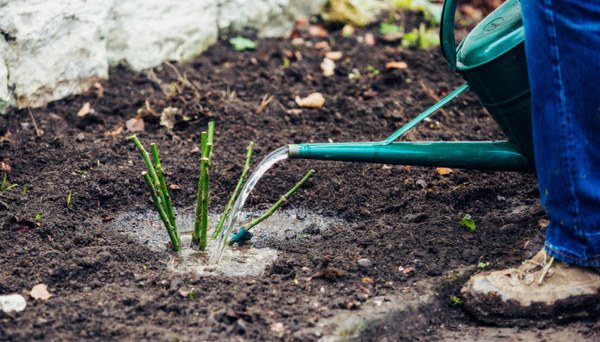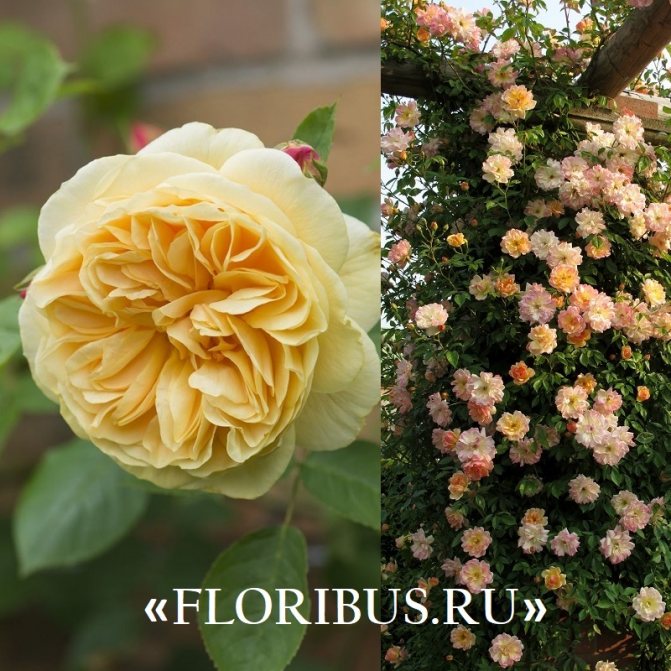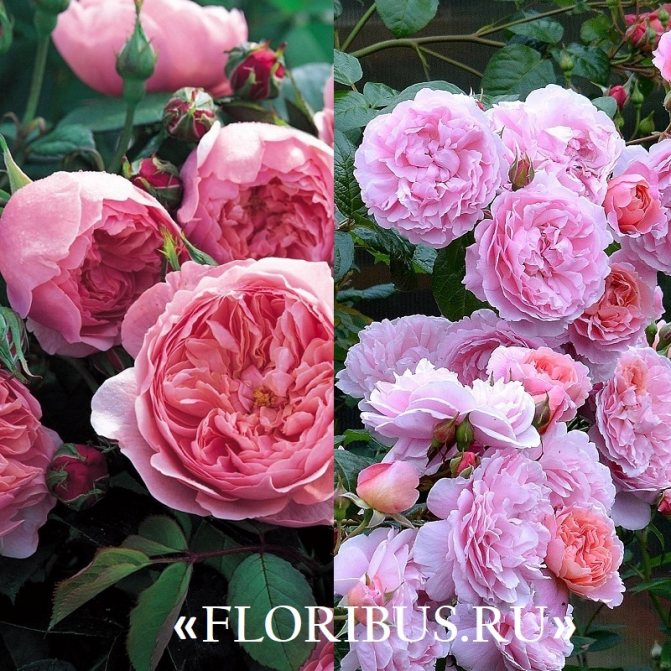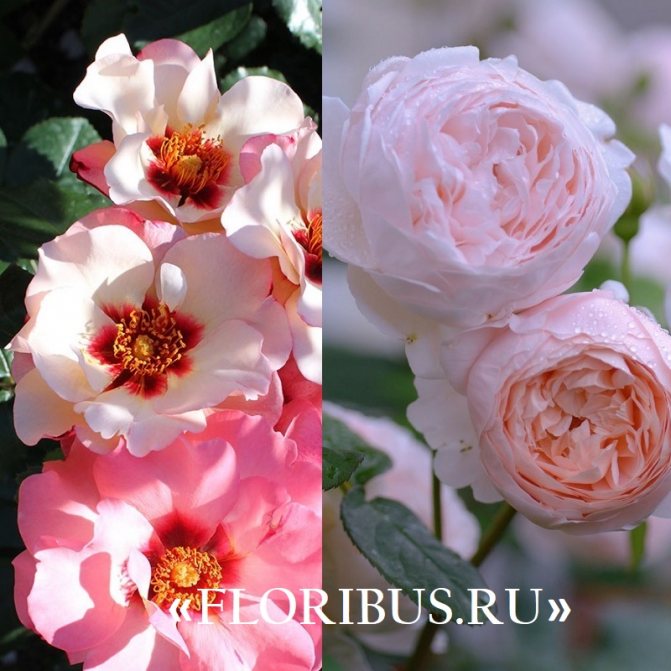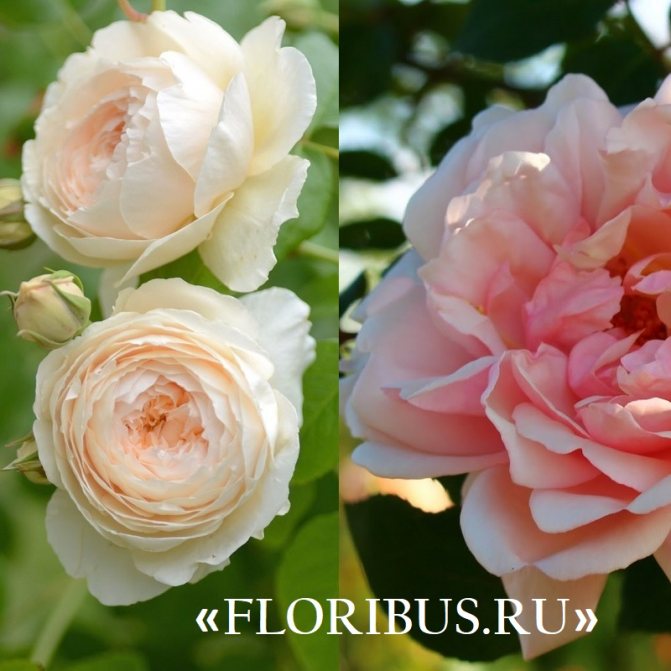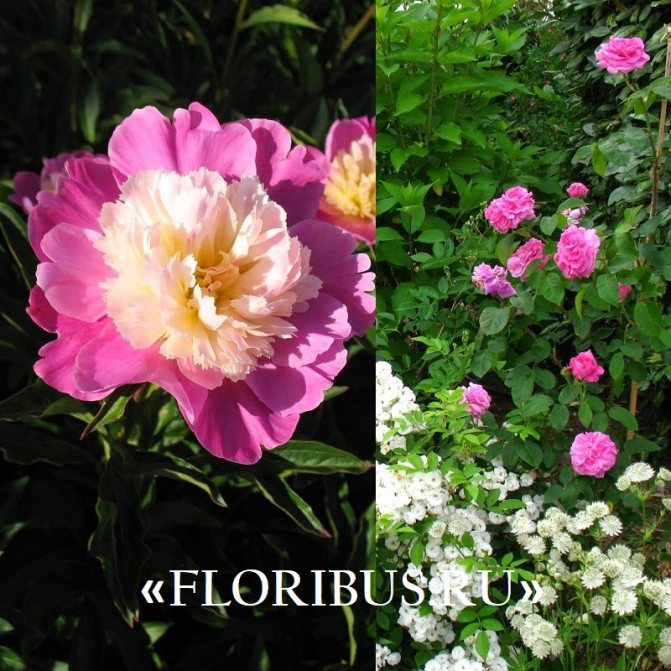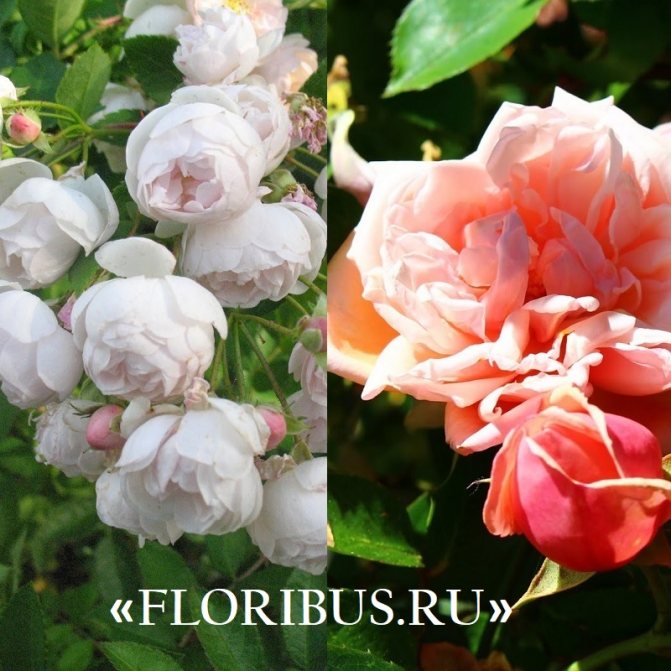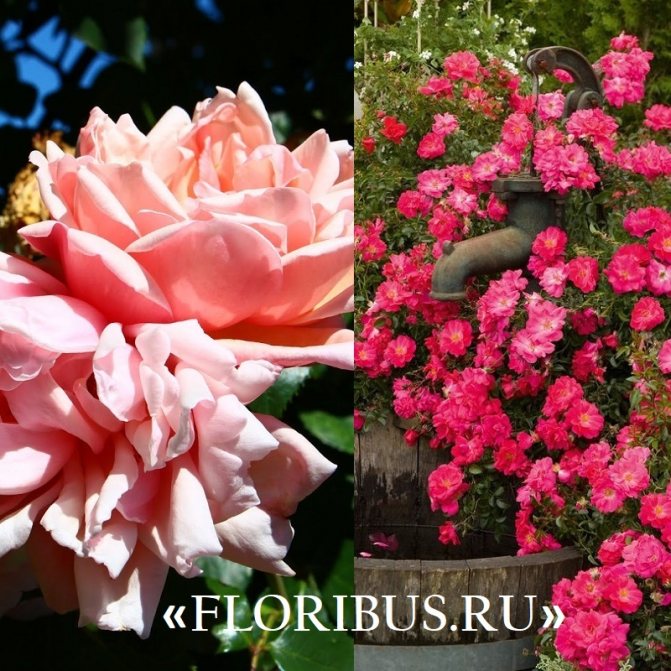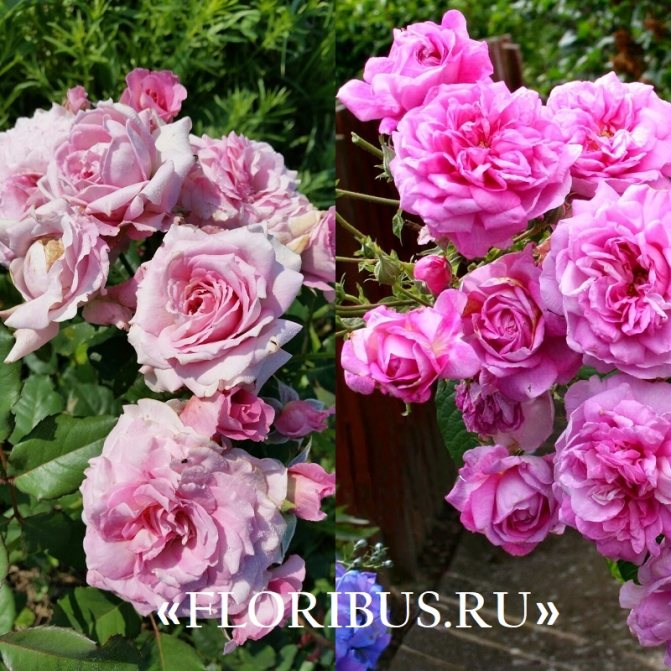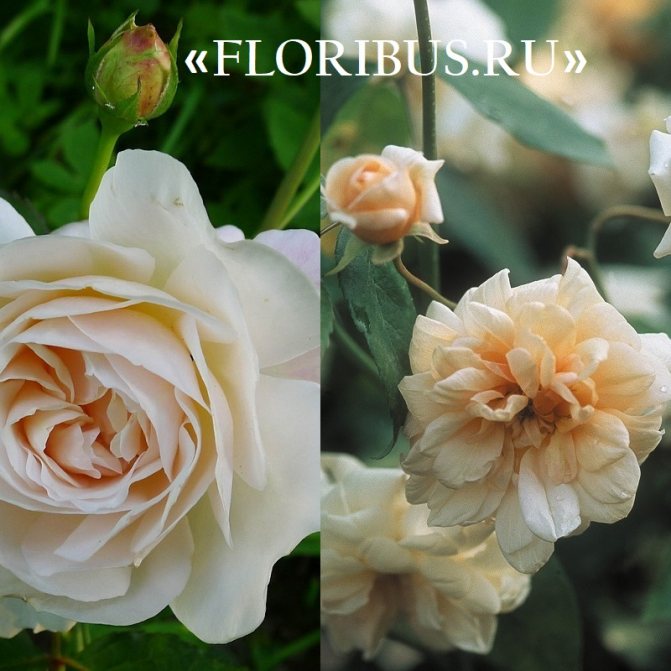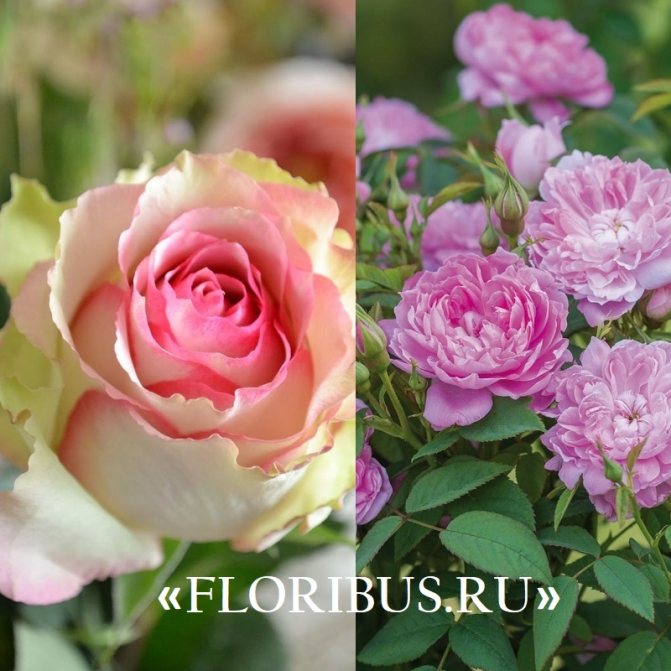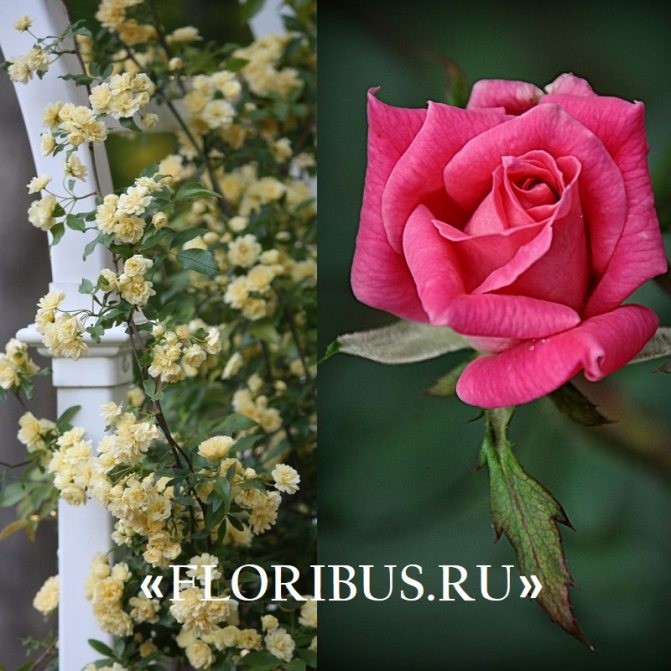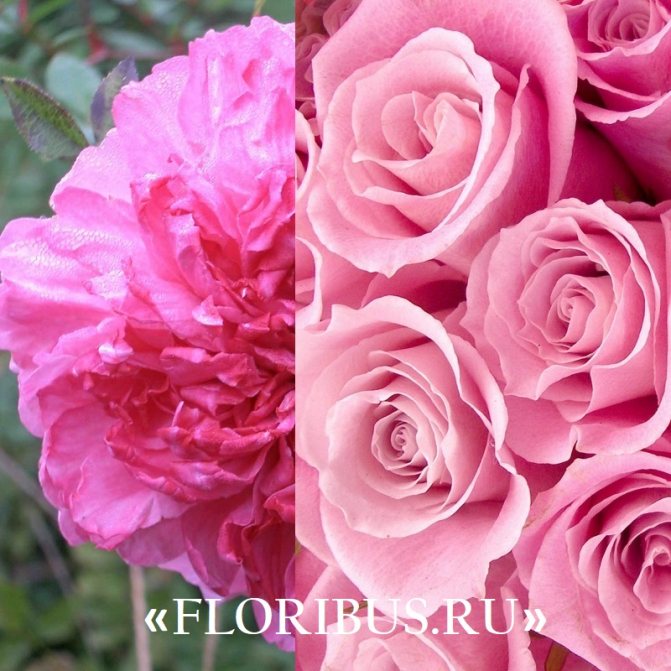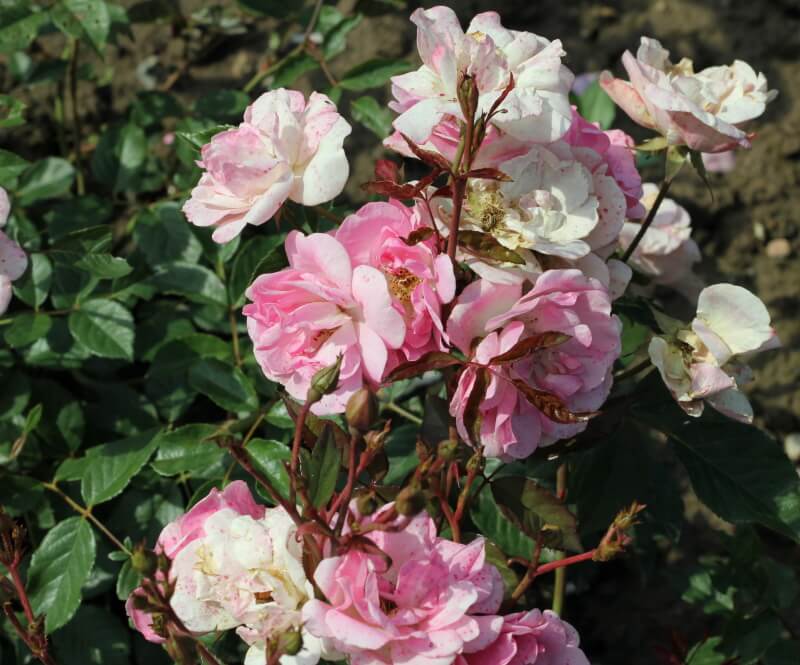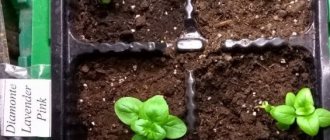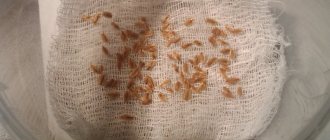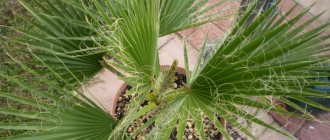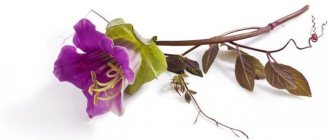In the 19th century, garden roses, bred by breeder Jean Baptiste Guillot, became fashionable, called polyanthus due to large inflorescences of simple and double buds. This name literally translates from Greek as "multi-flowered", thereby emphasizing the ability of the plant to actively bud. So, what polyanthus roses are is well known - it is a hybrid obtained by crossing a Chinese tea and a Japanese dwarf species. In the course of experiments with these flowers, numerous groups of floribunda varieties were created, created on the basis of polyanthus and hybrid tea roses. All their cultivation from planting to leaving on this page is presented in tips with videos, where real professionals share their knowledge and practical experience.
In Russia, this type is actively used for landscaping houses and personal plots in almost all regions. The fact is that the plant has a high resistance to frost and excellent decorative effect, which can be noted from the photo below.
The presented description of polyanthus roses with a photo will allow you to make a first impression, and proper planting and care will help create unusual options for the decor of rose gardens.
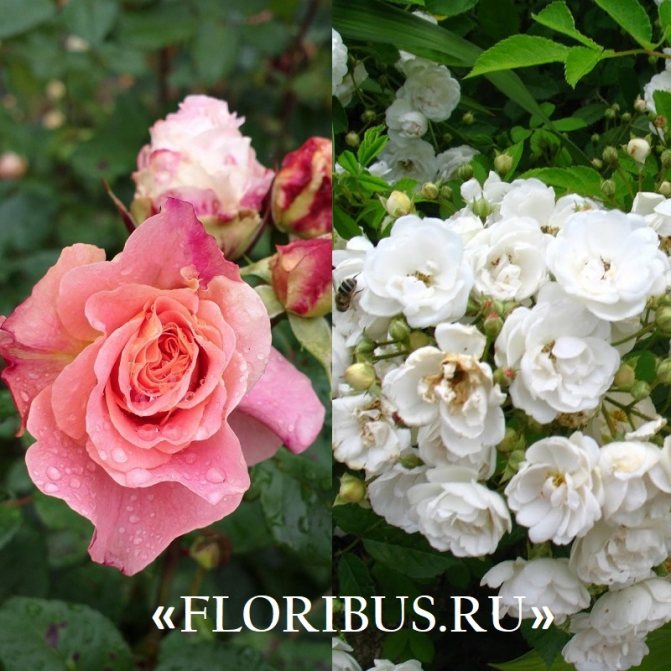
Description
Polyanthus roses first appeared in France at the end of the 19th century. There are two options for their origin:
- appeared when crossing the re-flowering variety Hybrid with a multi-flowered rose;
- the result of crossing the dwarf variety Rosa multiflora (rose hips) with Rosa chinensis (Chinese rose).
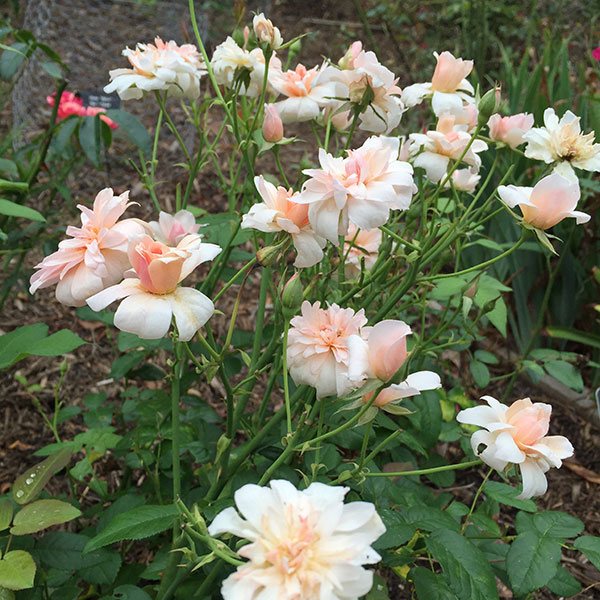

Since 1884, these hybrids have been combined into a separate group. Actually, the name "polyanthus roses" is translated as "multi-flowered rose". Description:
- racemose inflorescences, which include at least 10 flowers with a diameter of 4-6 cm;
- compact highly branched bush;
- the bowl of the bud is usually cupped;
- unpretentious in care;
- leaves are glossy, do not fade in the sun;
- foliage is medium-sized, very dense, rich green color;
- flowers are bright, usually pink or red, less often white;
- height, depending on the variety, from 30 cm to 70 cm.
Pest and disease control
Polyanthus roses are considered one of the hardiest representatives of the Rosehip genus, but this does not mean at all that diseases and pests never attack it. Below are the most common diseases of the "angel flower", their main symptoms, causes and methods of treatment.
Black spot:
| Symptoms | dark spots on the front side of the sheet plate; drying and falling of affected leaves |
| The reasons | excessive air humidity at a relatively low temperature (+ 19 ... + 25ºC) |
| Prevention measures | spraying with a decoction of nettle or ivy (used in case of prolonged rains) |
| Control measures | treatment with drugs based on penconazole, triazole or mancoceb ("Skor", "Topaz", "Ridomil Gold", "Profit"); spraying with "Fitosporin", "Tiovit Jet"; the use of immunostimulants ("Epin-Extra", "Zircon"). |
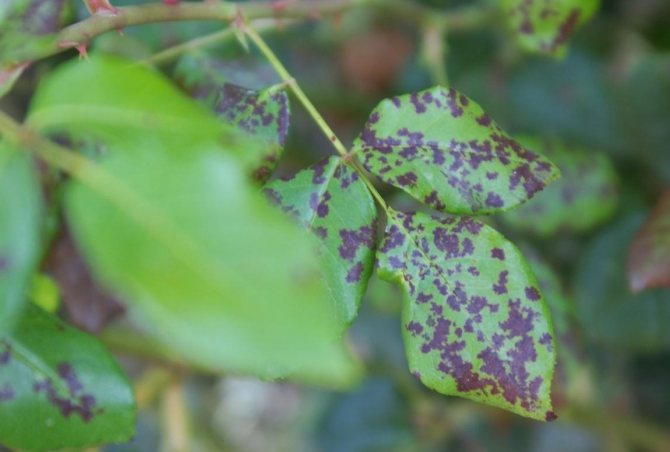

Powdery mildew:
| Symptoms | cobweb-like white coating covering the leaves; deformation of leaves; falling buds |
| The reasons | the disease causes a fungus that spreads very quickly in any weather and in any conditions, it just needs to get to the site |
| Prevention measures | timely application of phosphorus-potassium fertilizers |
| Control measures | spraying with Bordeaux liquid; treatment with soap and soda solution |
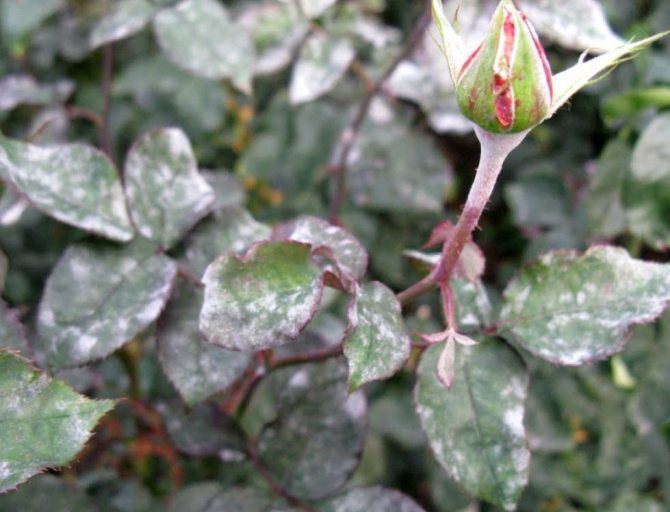

Rose rust:
| Symptoms | brown or yellow spots on the leaves; cracking of the bark; curvature of branches |
| The reasons | the fungus is often introduced to the rose from wild rose hips or is already present on a newly acquired plant; high humidity contributes to the spread of the disease |
| Prevention measures | spraying with Bordeaux liquid according to the following scheme: double treatment in April with a break of 3 days, then - 2 times a month |
| Control measures | treatment with "Toxin-M" or "Skor" preparations |
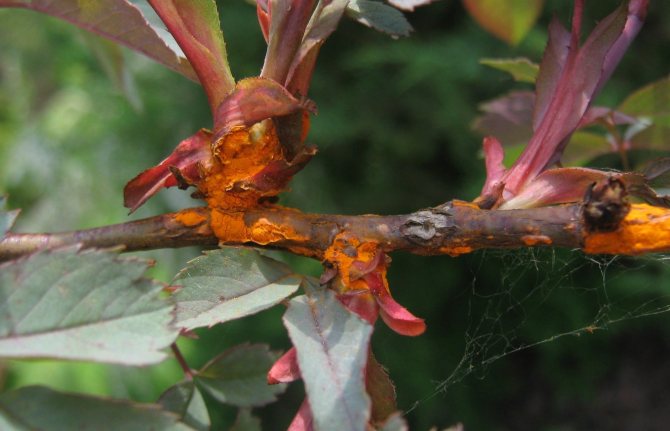

Of the pests of the polyanthus rose, the most annoying are:
| Parasite name | Symptoms | Control measures |
| Aphid | visible to the naked eye (tiny insects sucking juice from stems and leaves) | removal of the most affected areas of the plant; spraying with wormwood solution; insecticide treatment against sap-sucking insects (Tanrek, Biotlin, Kalash, etc.) |
| Rose leafhopper | visible to the naked eye in the lower part of the bush; appears on the leaves as white spots | saturated soap solution |
| Spider mite | yellow spots on the leaves; spider webs stretching from leaf to leaf | removal of affected parts; processing with infusion of garlic, yarrow or horsetail |
| Rose leaflet | rolling of leaves (usually occurs in early summer) | removal of affected parts; insecticide treatment ("Coragen", "Cesar", "Lipidocid", "Lieber", "Confidor", etc.) |
| Rosaceous rotten | small holes in the leaves | removal of affected parts; wormwood infusion |
Popular varieties
There are many varieties of this plant group. Polyanthus rose looks very impressive on garden plots. From the middle of the 20th century, they began to actively cross with tea hybrids. They are called floribunda. "Pure" and today popular varieties:
- Border King Feature: white petals along the edge have a bright red edging, refer to weakly double.
- Betty Prior (Betty Prior). The flowers are pink, odorless, thrive in cool climates. From even bushes of polyanthus roses, you can form a hedge.
- Cameo One of the most popular varieties. Double flowers, pink, with a pleasant aroma.
- Dagmar Spath. Snow-white large double flowers (up to 25 petals) are perfectly combined with blue varieties of other plants. The result is a spectacular "heavenly" white and blue composition.
- Manou Meilland (Manu Miland). At the beginning of flowering, the petals are painted in a delicate lilac shade. Gradually the color changes to dark pink. Has a sweet aroma. Abundant flowering and strong branching make it possible to create a continuous carpet of fresh flowers.
- Gloria Mundi (Gloria Mundi). Low-growing bushes with small burgundy-orange flowers. They bloom until the first frost, withstand strong winds and downpours. Keeps fresh for a long time after cutting.
Description of polyanthus roses (with photo)
According to the description of the polyanthus rose in other sources, it is a multi-flowered form that forms a dense dense bush, from 30 to 100 cm in height. The growth of a plant depends on many factors, first of all, on the variety of the hybrid and its variety. There are undersized, medium-sized and vigorous specimens (up to 150 cm). Some growers confuse polyanthus roses with floribunda, which is not worth doing, since, unlike them, these are plants with lush inflorescences of numerous small buds on a compact neat bush. Clear differences can be seen in the photo below. Also, please note that there are no yellow-flowered polyanthus varieties, in any case it is a different crop.
A feature of the multi-flowered form of the rose is that its stems practically do not have thorns. But they are strongly leafy. The leaves are most often dark green in color, but there are forms with light plates. The surface is glossy, smooth to the touch.
The flowering of polyanthus roses begins from the end of June and continues until frost. At the beginning of summer, budding of numerous small flowers, with a diameter of 4 to 10 cm, occurs. Some growers emphasize the disadvantage of this species in that its buds have a small color range. Typically, it includes shades of pink, red and orange. There are also varieties with snow-white buds or lilac tint. If you rummage through numerous hybrids, you can find specimens with petals of two colors, but this is very rare. Red or pink roses are more common, as in the photo below.
In general, this type of rose is distinguished by bright colors of green tops and flowers. They acquired such qualities from their "parents": rich foliage from Japanese multiflora, deep bright shades of buds from Chinese culture.
Polyanthus rose flowers do not have a bright aroma, their scent is unobtrusive and very subtle. Some varieties with fragrant buds that appear on young shoots of the plant.
One inflorescence can include up to 50 flowers, they are so densely packed that you cannot see the green tops from under them. In the cut, the buds last up to 7 days, after which they fade.
Advantages and disadvantages
Reviews of the polyanthus rose are the most positive. The owners note its undeniable advantages:
- proper care guarantees a luxurious bloom;
- you can admire the bush from the beginning of summer until the end of autumn;
- tolerate winter well, although the first three years require additional insulation;
- undemanding to soil;
- shade-tolerant;
- do not have thorns;
- have good frost resistance;
- resistant to various diseases of roses, but a damp and cool summer can provoke a fungal attack;
- do not need pruning, only sanitary and sometimes corrective ones are carried out;
- widely used as landscape plants;
- thrive in countries with difficult weather conditions;
- well cuttings: in autumn - woody cuttings, in summer (June-July) - green;
- for a long time, up to 2 weeks, they stand in the cut, while they do not lose the brightness of the color.
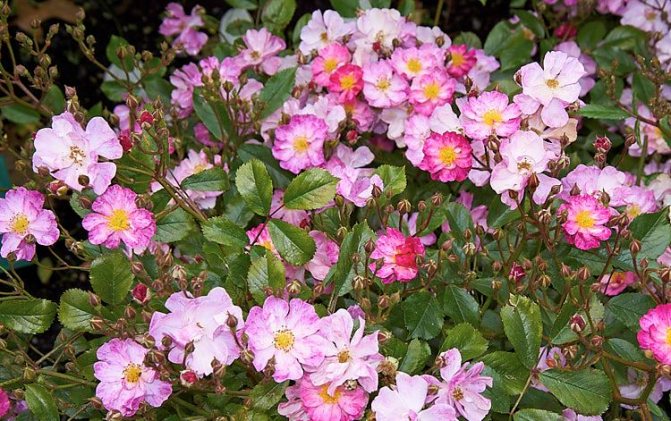

A distinctive feature is the ease of growing bushes of polyanthus roses from seeds at home.
A few cons:
- the vast majority of varieties are odorless;
- flowers are smallish;
- in the southern regions, the petals are burned out, slowly, but still the color changes;
- flowers cannot self-clean; additional care is required to remove them.
Basic rules for growing and care
Polyanthus roses are easier to care for than other plant varieties, but a beginner grower still needs to know and strictly follow certain requirements.
Location and optimal conditions
All roses are light-loving plants, and Polyantha is no exception. The bush will grow best in an open, well-lit, but at the same time protected from gusty winds place (polyanthus roses tolerate drafts better than other plant varieties, but this factor is still stressful). In the shade, the bush stretches out and loses its decorative effect, and in the absence of normal air circulation, it begins to hurt.
Did you know? The average lifespan of a rose is 30-40 years, but in the German city of Hildesheim a bush grows, the age of which, according to local residents, is a thousand years.
Polyants can grow in different climates, even in such harsh ones as the Urals and Siberia. The plant is not very demanding on the composition of the soil, but prefers loose and fertile soil with a neutral reaction.However, with good care, slightly acidic soil is also not an obstacle to good flowering. The rose can grow equally well both on clay and sandy soil. As for humidity, dry air (no more than 50%) is more suitable for an angel rose.
Mulching
To better retain heat and moisture in the soil, control weeds, and also prevent attacks from slugs, caterpillars and other crawling pests, an agricultural technique such as mulching is used. For these purposes, it is best to use wood chips or bark, but sand and even small pebbles are also suitable. Covering the soil circle around the bush with such material, the florist stimulates metabolic processes in the root system of the plant, increases the air permeability of the soil, and also gives his flower bed a more neat and well-groomed look.
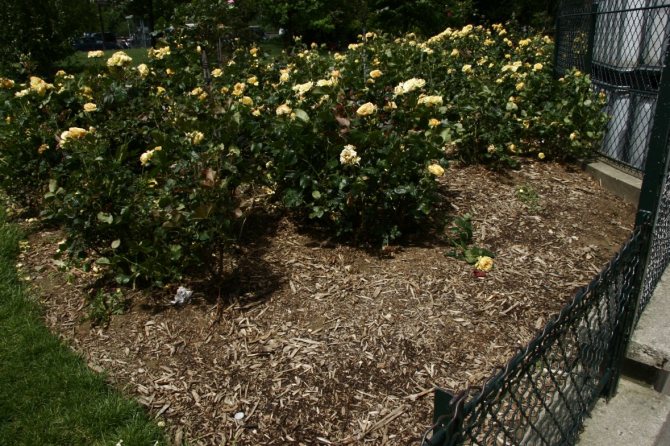

Watering and fertilizing
Angelic flowers do not need watering too often. Depending on the air temperature, you can water the flower bed once a week or even less often. The exception is young seedlings, in dry weather they should be watered every 6 days. Starting from the second half of August, the amount of moisture introduced into the soil should be reduced so that the bush does not release new shoots, which still will not have time to form before the arrival of cold weather.
Recommended reading
The most fragrant and fragrant varieties of roses
If mulching has not been carried out, after watering, the soil circle must be loosened to ensure air circulation and preservation of moisture in the soil, while simultaneously removing weeds that have appeared. Roses need to be fed with both organic and mineral fertilizers, alternating between them. However, it should be borne in mind that the first feeding after planting a bush can be carried out no earlier than 12 months later.
Chicken droppings can be used as organic food. To prepare the working mixture, the fertilizer is first diluted with 20 parts of water, left to stand for a week and then again diluted with water in a ratio of 1: 3. With the resulting infusion, the bushes are watered at the beginning of the season and at the end of each flowering period. In addition to chicken droppings, roses respond well to mullein, rotted manure or compost.
As for mineral fertilizers, the scheme for their use looks like this:
| Type of feeding | Sample drug | Application time |
| nitrogen | "Urea", "Ammonium nitrate" | at the beginning of the season; after the first wave of flowering |
| complex (phosphorus-potassium-nitrogen) | "Ammofoska", "Nitrofoska", "Superphosphate" | starting from July - 2-3 times per season |
Pruning
Pruning roses is a must for any variety of this plant. For the Polyantha group, this procedure has its own characteristics. So, to ensure high branching and, accordingly, abundant flowering, a young bush is radically shortened immediately after planting, leaving 2-3 eyes on each shoot for low-growing varieties and 1-2 eyes for tall varieties. In addition, you need to remove all old (dry, woody or darkened), diseased and weak shoots, cutting them off at ground level.
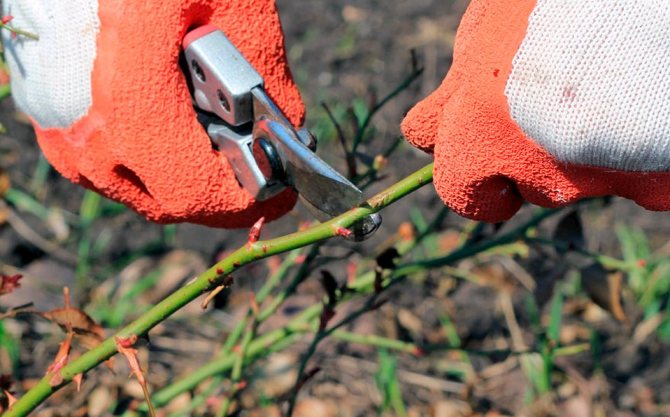

In subsequent years, the procedure is carried out according to the same principle - strong shoots are shortened by a third, all others are removed. The number of shoots that should be left for further development depends on the age of the bush: in young people this number can be limited to 3-4, then increasing it to 8. During the flowering period, pruning is carried out only in relation to dried peduncles. In autumn, sick and unformed branches are cut for sanitary purposes.
Important! The weaker the rose, the more it needs to be pruned. But it is not recommended to drastically shorten strong and tall varieties, since after such a procedure the plant begins to grow intensively, which can lead to a later and less abundant flowering.
Shelter for the winter
Polyanthus roses are hardy plants and can tolerate temperatures as low as -15ºC. Nevertheless, it is recommended to cover them for the winter. In regions where winters are not too harsh, a light shelter from fallen leaves, peat or coniferous paws is enough for a bush, but if severe frosts are expected, especially in the absence of snow, the issue of protection should be taken more seriously. In this case, in addition to shelter, the bush should also be earthed up to a height of 10 cm.
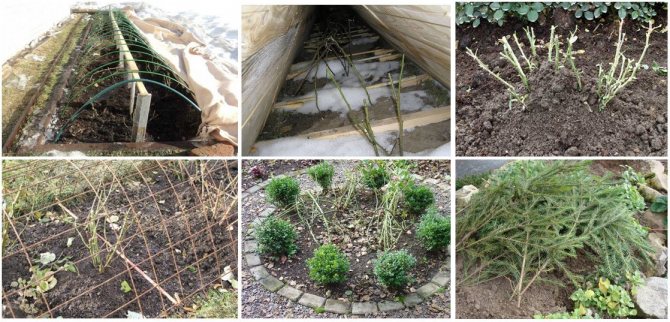

Bushes should not be cut and covered too early. On the one hand, pruning before the onset of the first frost is perceived by the plant as an incentive for active growth, as a result of which the rose may simply die. On the other hand, a gradual cooling for the bush is a good hardening and preparation for wintering. The best time for the procedure is the period when the night temperature has dropped to -2… -3ºC at least once (depending on the climatic zone, this can be the end of October or November).
When covering roses, one should be guided by the following rules:
- The procedure is carried out in dry weather.
- Only dry materials are used for shelter.
- The shelter is preceded by sanitary pruning.
- The insulating layer must be well and securely fixed, otherwise the structure will collapse under a gust of wind.
With the onset of spring, the shelter is not completely removed, but only slightly opened to provide oxygen access to the plant. When the bush starts up young shoots (usually in April), the "cover" can be removed completely.
Important! Polyanthus roses rooted from cuttings are rather weak in the early years, so they need to be covered especially carefully for the winter, otherwise they may die.
Reproduction
One of the most valuable qualities of the polyanthus rose is that it multiplies very easily, and for this you can use almost all methods - from planting seeds to various vegetative methods (cuttings, layering, grafting, dividing the bush):
- Seeds "Angel flower" can be purchased in a store or assembled by yourself, for this you just need to open the not fully ripe fruit. Before planting, the seeds must undergo stratification (a procedure that simulates the wintering of seeds in the soil). To do this, the prepared material should be laid out between two layers of damp cloth, wrapped in polyethylene and placed in the refrigerator (vegetable compartment). From time to time, the fabric needs to be ventilated and additionally moistened. You need to start the procedure at the beginning of winter. By about February, the seeds should "hatch" (put out the first thin root). Once this happens, they need to be planted in a small pot and placed in a warm, well-lit place. When a young plant gets stronger, it can be planted in open ground. The best time to do this is in the fall.
Video: seed propagation of roses
- For breeding Polyantha cuttings at the beginning of summer, a lignified shoot is cut off from the plant and divided into segments with one or two buds on each. Then the cutting is processed with a rooting agent ("Kornevin", "Heteroauxin", etc.), buried in a mixture of peat and sand at an angle of 45º, covered with a jar or plastic bottle and placed for rooting in a warm and slightly shaded place. You can plant such a cutting in open ground next spring, while during the winter the plant should be in a cool room at a temperature slightly above zero.
Video: propagation of roses by cuttings
- To get multiple plants from one bush the rose must be carefully dug out of the ground and, without completely cleaning the earthen lump, cut the root together with the aerial part into two or three parts with a clean and sharp knife. Plant each fragment obtained in the usual way, having previously powdered the cut area with crushed charcoal for disinfection.
Important! It is not recommended to decorate lawns with roses, since the presence of a decorative bush makes it very difficult to cut the grass.In addition, a neat and well-groomed lawn is a self-sufficient design element, so tall flowers on it look alien and cause a feeling of disharmony.
Reproduction methods
These varieties can be propagated in several ways:
- Vegetative reproduction:
- Grafting of roses with buds, or budding. What quality grafted roses will grow depends largely on the choice of the rootstock. It must be resistant to diseases, longevity, intensive growth, winter hardiness, long growing season, and tolerate drought and excess moisture well. It is better to grow the stock yourself. In most of Russia, the Rosa canina rosehip will be the best choice for the stock.
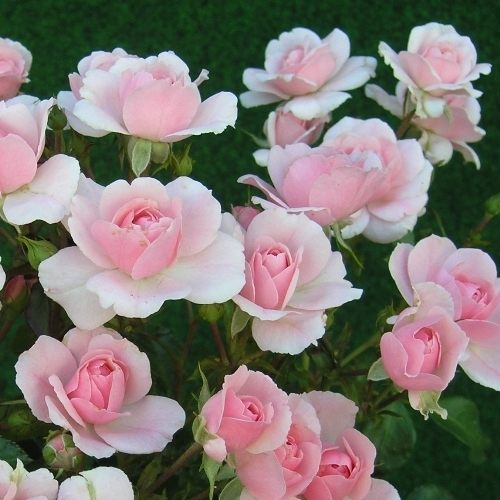

- Cuttings. A very effective way to propagate polyanthus roses at home. Summer herb cuttings (most common) or winter greens can be used. Not too thick cuttings are selected: vigorous ones can rot during transplantation, and very young ones do not have time to develop enough before the onset of cold weather and die in cold weather. To save even strong shoots for the winter, they are wrapped.
- Division of the bush. A great way, it allows you to immediately form a bush. A heavily overgrown bush can die, and this method allows you to rejuvenate and heal the plant. This method is used for roses grown from cuttings. The division is carried out either in early spring or in autumn.
- Layers. Held in early spring. Choose a strong shoot closer to the root collar. Until autumn, the cuttings, as a rule, root well, they are planted from the mother bush. If the root system is weak, leave for another year.
- From seeds. The polyanthus rose is one of the few that can be grown from a full-fledged seed. Judging by the gardeners' reviews, the bushes grown in this way have absolutely the same characteristics as the original plants.
Planting flowers
Seedlings of polyanthus roses are best purchased in specialized stores, where you can choose the right variety, as well as get detailed advice on planting and care. However, before you start shopping, you need to do some preparatory work.
Did you know? The most expensive rose in the world is estimated at £ 3 million. The variety is called "Juliet", and its author is the famous English breeder and owner of the company of the same name, David Austin, who spent a decade and a half of his life creating a magnificent flower.
Preparatory work
The place for planting roses must be prepared in advance. It is best to do this at the end of summer, since you cannot plant a bush in the newly dug ground: after the soil subsides, the roots of the plant can become bare, and the rose will freeze at the first frost.
Preparatory work includes:
- choosing a suitable place;
- cleaning the site from debris, small stones and weeds, and it is necessary to remove not only the aerial part of the plants, but also their roots, even the smallest;
- digging the earth to a depth of about 20 cm;
- fertilization: organic (compost or rotted manure) and mineral (primarily phosphoric, but complex fertilizers can also be used); it is recommended to lighten too heavy soil by adding sand, and for additional disinfection it is useful to mix in a little crushed charcoal;
- shelter: so that the prepared place for the rose does not dry out, it should be covered with a healthy green mass, for example, freshly cut grass, or peat.
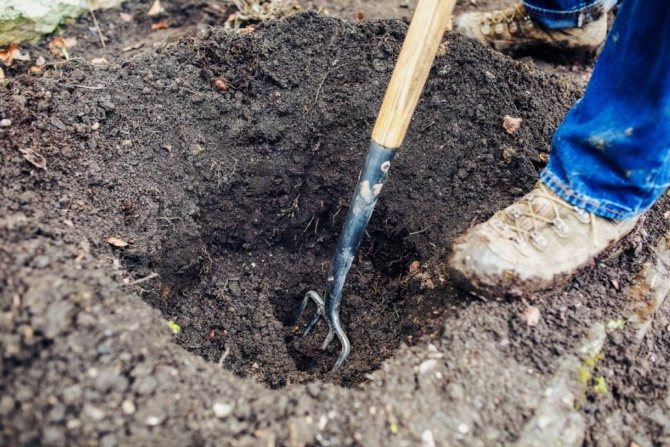

Planting technology and timing
Roses can be planted in fall or spring. The first method is more preferable, because in this case, before the onset of frost, the bush has time to root well, without being "distracted" by the active growth of the aboveground part. When planting in spring, the plant outwardly begins to develop very quickly, but due to the fact that the fragile root system is forced to direct all its forces to the growth of stems and flowering, the bush may enter insufficiently prepared in the next winter.It is for this reason that roses planted in spring freeze out much more often.
Important! On heavy and waterlogged soils, polyanthus roses are planted only in autumn, because after winter such soil becomes too dense, and the forming root system does not receive enough oxygen.
The planting process involves the following actions:
- Remove the shelter from the prepared place.
- Dig a hole in the ground 40 cm deep and the same diameter. Fertilizers do not need to be applied to the bottom of the hole!
- Cut dry, broken, damaged and thin branches from the seedling, leaving only 3-4 of the most healthy ones. If the bush is small and weak, cut off the shoots to the level of one eye; in the strong, you can leave several buds.
- Carefully examine the roots, remove the damaged processes, shorten the rest by a third.
- Place the seedling in the hole, making sure that the roots do not break or bend, but are freely located throughout the area.
- Holding the plant so that its growing point is just below ground level, fill the hole with about 3/4 of the potting mix.
- Very carefully tamp the soil around the seedling.
- Water the bush with slightly warmed water.
- After the water has been absorbed, sprinkle a thin layer of dry earth on the soil circle.
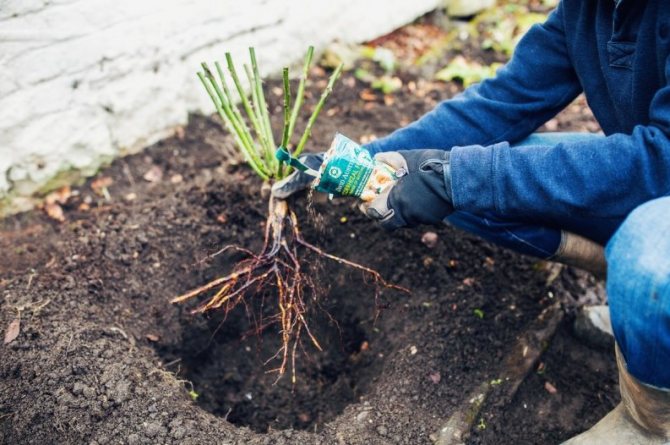

Seed collection
In order for the cultivation of the seeds of the polyanthus rose to be successful, it is imperative to take care of the quality and preparation of the seed. Purchased seeds do not always meet expectations. Easier to collect yourself or take in the nearest rose garden. The seeds are harvested from unripe fruits (blush rather than completely reddened) at the end of summer. Cut the boxes and carefully separate the pulp from the seeds.
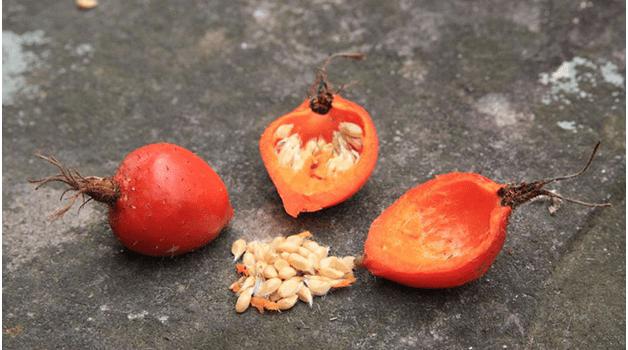

Dried or rotten seeds are not suitable for planting. The collected material does not need to be dried. Immediately after collection, they are washed in hydrogen peroxide. Such a simple procedure will help prevent mold and will serve as an excellent tool for disinfecting seeds.
Acquaintance
The bush of polyanthus roses is compact, with small bright green leaves, through which small but bright flowers are abundantly visible. The petals are mostly red, but also white. The petals grow up to 2 cm, smell nice and seem terry.
A rose bush with densely growing stems grows up to 60 cm. Each branch produces up to 50 polyanthus dwarf roses.
Florists know the resistance of polyanthus roses to diseases and pests. With a small shelter, the plant is able to withstand winter frosts.
Seed preparation
The seeds of the polyanthus rose are classified as tightly similar. And this is reflected in the breeding process. Growing a polyanthus rose from seeds at home takes time. To plant young bushes of plants in the spring, work with seeds begins already in early February. Sometimes, to accelerate germination, they are treated with a growth stimulator before germination. Germination of seeds, or stratification:
- take gauze folded in several layers, or a cloth and moisten with hydrogen peroxide;
- seeds are carefully laid out on the fabric;
- cover the top with the same damp piece of cloth;
- "Sandwiches" with seeds are placed in plastic bags - this will prevent the evaporation of hydrogen peroxide;
- to control germination, the start date of work is put on the packages;
- the packages are put for storage in a refrigerator, in a compartment with a temperature of +5 0С;
- periodically check the seeds for the presence of mold, when it appears, they are replaced with new ones;
- if the storage conditions were observed correctly, the first shoots will appear in 7-8 weeks;
- seeds with sprouts are planted in the ground, the rest are stored further.
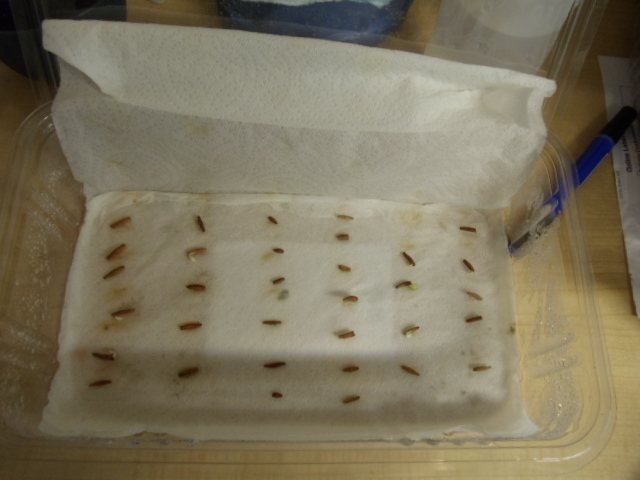

A more time-consuming variant of stratification consists in storing seeds for 8 months. The collected seeds are mixed with clean wet sand, laid out in boxes and left (usually in the basement) at a temperature of no more than +3 0C.Constant air circulation and adequate sand moisture are prerequisites.
Caring for polyanthus roses to maintain decorativeness (with video)
In any climatic conditions, polyanthus roses are not demanding to care for. Most of them grow in full sun without fading or other damage. But the scorching sun can be destructive for them, especially at a young age. Nevertheless, a plant can lose its decorative effect only in two cases: hibernating without shelter and growing. Both problems can be prevented by caring for the bush throughout the year. Maintaining decorativeness is very important for roses, otherwise the plant may die without flowering. Some of the nuances of growing picturesque bushes in the garden and at home, you can watch the video about the polyanthus hybrid.
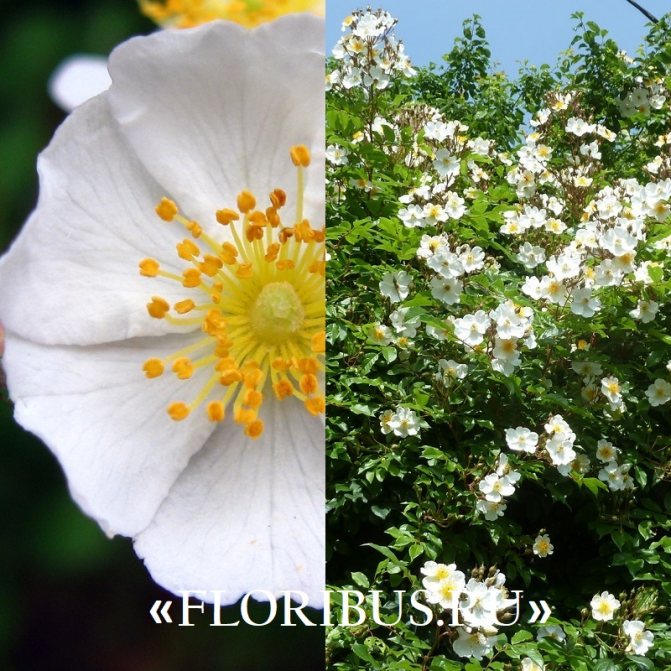

Since spring, it is important to fertilize polyanthus roses with mineral fertilizers; instead, you can use a solution of chicken manure. It is done as follows: in a ratio of 1/20, the fertilizer is dissolved in warm melt water and infused for a week, after which time the fertilizing must be diluted again with an equal amount of pure water.
Watering polyanthus roses is recommended only from the beginning of the budding period to the end of flowering, no more than once a week. It is more important to prune withering buds and old shoots. In the spring, 1/3 of the adult stems are removed to maintain the decorative effect of the bush.
Seedling
Getting seedlings:
- sprouts are planted in small pots;
- the pots are placed in a cool place, not in direct sunlight, but with sufficient natural light;
- the soil is mulched with perlite (a layer of 1 cm is enough);
- constantly monitor soil moisture;
- young shoots necessarily select the best, getting rid of too thin, weak and crooked;
- seedlings are provided with 10-hour daylight hours, for which special lamps are used;
- seedlings are regularly fed.
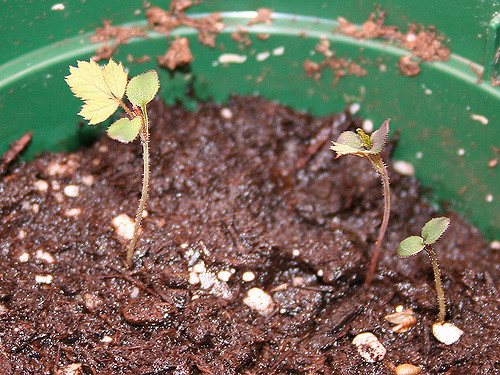

Testimonials
Polyanthus roses are quite in demand among gardeners, as evidenced by numerous positive reviews.
In addition to exceptional decorative properties, it attracts the possibility of growing in a variety of ways:


- seeds;
- cuttings;
- dividing the bush;
- layering.
Cutting, along with seed propagation, is used most often. At the same time, the reduced winter hardiness of plants grown from cuttings is noted: for the winter they necessarily require shelter.
Amateur flower growers are attracted by the unpretentiousness of polyanthus roses. It is quite simple to grow them, they are not as susceptible to diseases as roses of other groups, and are less afraid of cold weather. Thus, many varieties are able to grow without shelter for the winter in frost resistance zones up to 3b according to the USDA classification.
Compact bushes harmoniously fit into both large and small flower beds, look great in containers and flowerpots in the form of borders along the paths. Moreover, unlike other groups, polyanthus roses almost always have flowers during the warm season.And even when dried, they often do not lose their attractiveness, so that the bush resembles a cloud of flowers almost before the cold weather.
The miniature size of polyanthus roses was appreciated by gardeners of Siberia, the Urals and other cold regions: air-dry shelters are easily made for them. In order for the plant to continue to live and develop, it is enough to keep the shoots by 10 cm.
Landing in the ground
If the seedlings of a polyanthus rose from seeds (reviews of amateur gardeners confirm this) are planted in April-May, it will have time to take root firmly and endure the winter well. This is the best option for the regions of central Russia. In the south, seedlings are planted in the ground for their permanent "residence" in the fall.
The landing site requires some preparation;
- the soil must be warmed up to at least +10 0С;
- before planting seedlings, the soil is dug up and organic is added at the rate of 1 kg and 1 tablespoon of mineral fertilizer for flowers (it is mixed with the soil) per 1 bush;
- the depth of the fossa depends on the size of the roots, they should be placed in it in a straightened state;
- seedlings are placed at a distance of 0.5 meters from each other;
- shoots are pruned, leaving 2-4 buds, weak branches are pruned almost completely;
- after planting, the seedlings are abundantly watered and spud;
- after two weeks, new stems appear.
If there are no signs of fresh shoots, the soil is mulched with sawdust (leaves can be used) to better retain moisture. After the emergence of shoots, excess soil is carefully removed.
Mulching
Benefits of mulch:
- polyanthus roses can be watered less frequently. Mulch prevents the soil from drying out by half;
- soil fertility improves;
- protects the plant from the effects of cold.
You can sprinkle the bushes with dried grass, soil or rotted sawdust. You can mulch in spring, summer and autumn when preparing polyanthus roses to endure the winter cold.
Watering. Watering polyanthus roses is necessary after the soil dries, after about a week.
Subcortex. To feed polyanthus roses, you need to add a large spoonful of Cytovita to the hole when planting a seedling. After half a month, repeat this procedure.
In spring, polyanthus roses need to be fed with mineral fertilizers. Organic matter is introduced in July. In the fall, feeding is canceled.
Second option
There is another way to get seedlings from seeds. Commencement of work in December:
- Soak the seeds in water at room temperature for two weeks.
- They are planted in a moist substrate for indoor plants to a depth of 0.5 cm.
- The pots are covered with glass (you can use a film) and put away in a cool place.
- Within a month, the soil moisture is monitored and ventilated (the glass is slightly opened for a while).
- After emergence, they are exposed in a well-lit place, but not in direct sunlight.
- The first summer sprouts are best left on the loggia or balcony.
- Ready bushes are planted in open ground in April-May in the second year of life.
Various varieties of polyanthus roses
Since the appearance of the hybrid, many different varieties have been bred into the culture. But, it is worth noting right away that some unscrupulous sellers can deceive the future owner of a polyanthus rose, passing off a seedling for this species. This must be monitored very strictly, especially if you want to plant a crop in open ground. The fact is that, for example, in the Urals or Siberia, conditions are not favorable for all roses, polyanthus are one of those who easily winter under cover in harsh winters. Even with severe damage to shoots in frost, in spring, when warmth comes, they quickly recover. At home, flower growers love to grow polyanthus roses due to the fact that they are able to form a compact bush and look very attractive as a potted culture. For home planting or as a curb plant, it is recommended to try low-growing varieties, namely:
1) "Angel Wings" - a bush no more than 30 cm high, with small double buds and glossy green leaves. There are some varieties with simple flowers
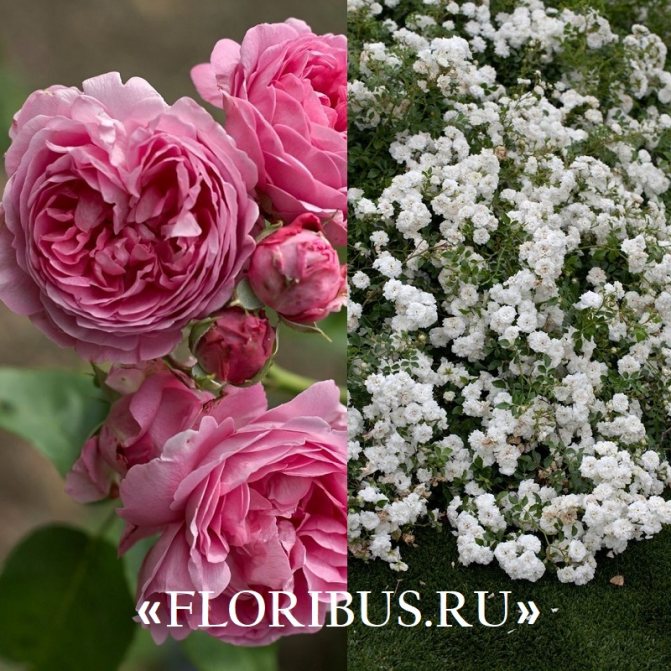

2) "Ivanno Rabier" is a fragrant bush with abundant flowering of numerous white buds. The inflorescences of the plant are very large, terry
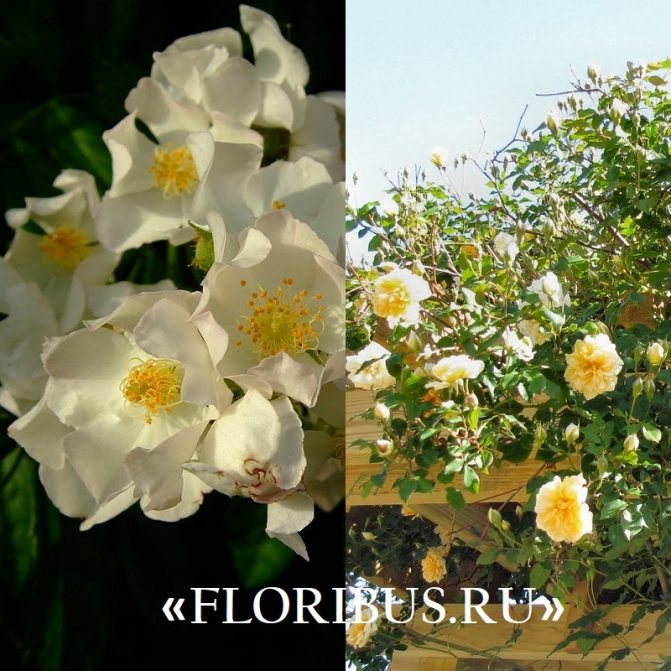

3) "Orange Triumph" - plant height no more than 50 cm. A sprawling bush is perfect for landscaping borders. During the flowering period, forms orange, orange-red buds, collected in large inflorescences.


For planting in groups on flower beds, you can take a closer look at the following groups of polyanthus roses, namely, medium and vigorous:
1) "Spartak" - a variety up to 70-80 cm high with large spherical buds collected in luxurious orange or red inflorescences
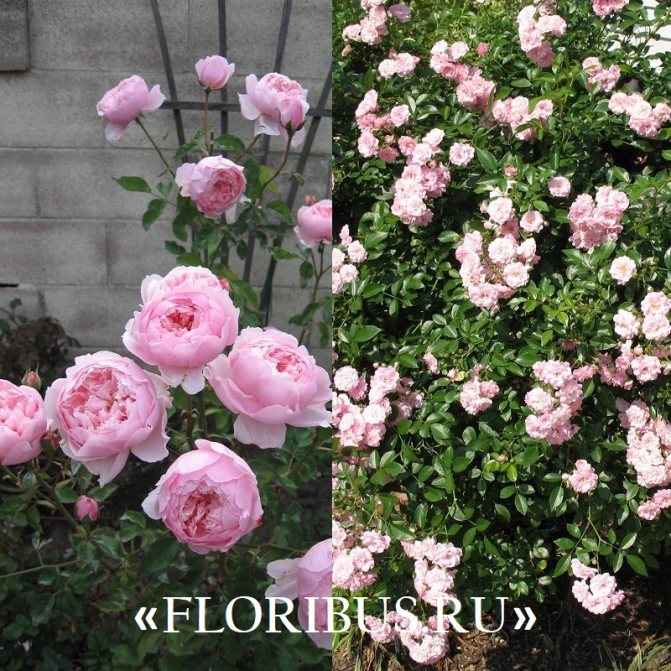

2) "Flame of the East" - a Russian variety with double red flowers, most often you can find single buds (they are more attributed to the tea-hybrid form or floribunda) or with large inflorescences
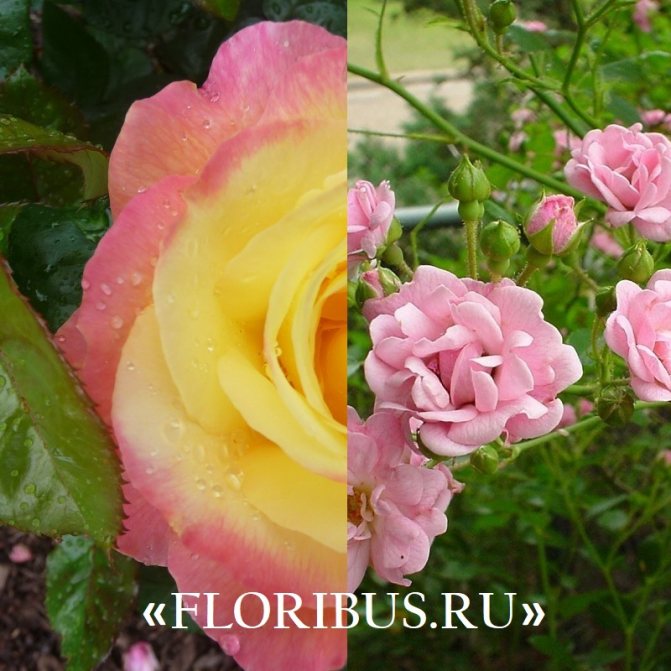

3) "Concert" - bush height 60 cm. Numerous small red flowers, collected in large inflorescences


4) "Georg Elger" - medium-sized bush with orange or salmon flowers


5) "Iceberg" is one of the tallest bushes, its height can reach 120-150 cm. Perfect for landscaping vertical structures. Differs in snow-white flowers with a pleasant aroma. The buds are very double (from 50 petals), collected in large inflorescences
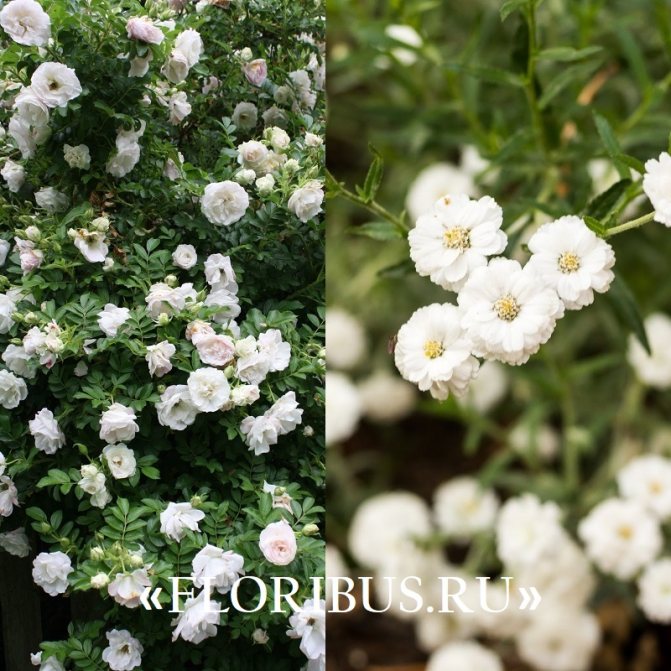

6) "Masquerade" - suitable for compositions, bush 70 cm in height with strong shoots. Against the background of dark green foliage, numerous red, orange and pink buds flaunt, which can change color as the bud opens. Large semi-double flowers
There are also such tall polyanthus roses: Manou Meilland and Marchenland with pink petals of buds and Holastein with dark ruby large inflorescences.
Roses on the windowsill
Low bushes grow well in indoor conditions. Seedlings are planted not in their summer cottage, but in a more spacious pot. Then they take care of them, like a rose in a garden bed. It requires watering, feeding, periodic pruning. This stimulates the growth of new shoots and helps control the size of the bush.


Experienced florists recommend following these rules:
- the best place in the apartment will be the west or east side;
- roses love humid air, to humidify it, you can put a container of water near the flowers;
- optimal temperature +25 0С;
- flowers need fresh air, the room must be regularly ventilated;
- the soil should be loose and nutritious;
- the rose requires abundant watering;
- the flower requires space, overcrowding oppresses them, in addition, contributes to the rapid spread of pests and diseases;
- wilted flowers must be removed immediately, this will extend the overall flowering period of the bush.
Use in landscape design
Compact, hardy and unpretentious, besides, long and profusely blooming polyanthus roses from the time of their appearance are a real find for landscape designers. However, if large bushes of park and hybrid tea roses are usually placed in front of the entrance to the house or in the central point of the site, so that the bright colors, noble forms and delicate aroma of these plants emphasize the taste and status of the owners, then small but lush polyanthus roses are more often used as a picturesque edging of paths, around gazebos, as well as in remote and romantic corners, where their tenderness, romance and sentimentality will be much more useful.
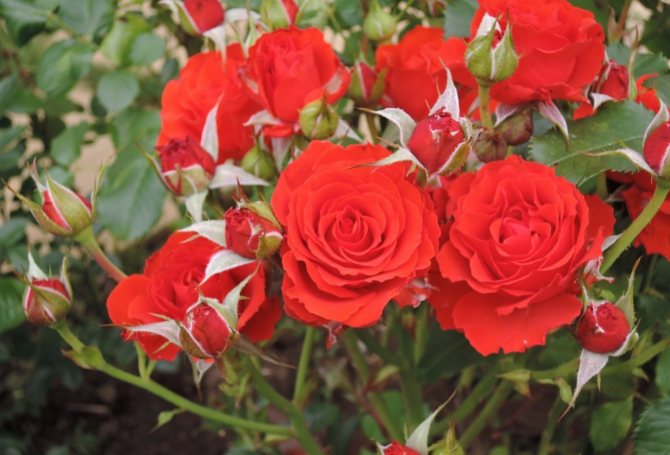

Designers recommend using varieties with red flowers for owners of houses with white walls, since scarlet paints look especially stylish on a light background. Low-growing Polyantha varieties are best used as a curb plant.They are usually planted at a small (from 30 to 50 cm) distance from each other, due to which, growing, the bushes create a single flowering "path".
Polyanthus roses are the best suited for the design of the so-called rabatki - narrow rectangular flower beds located in front of the house or along the fence. A composition of bright and numerous red or pink flowers that cover low bushes with a cap can be blue or white shades of wildflowers - cornflowers, lavender, sage, delphinium, bells, iris, lilies.
Learn about the smallest varieties of roses.
Polyantha looks very beautiful in separate containers or pots, which can be used to decorate not only a gazebo or an entrance to a house, but also an open balcony or veranda in an ordinary city apartment, adding elements of landscape design to it.
Polyanthus roses have a huge number of undeniable advantages. Their flowers are not as refined and fragrant as those of hybrid tea varieties, however, in the courtyard of a private house or in a summer cottage, unpretentious plants, easy to care for, and most importantly, differing in almost continuous and very abundant flowering, are much more valuable. It is these qualities that Polyantha is famous for; it is not for nothing that this type of roses has been gaining more and more popularity in recent years.
How to reproduce?
Cuttings
What we need:
- high-quality stalk;
- earth and sand;
- pure water;
- plastic or metal growing container and lid;
- root (root growth stimulant);
- scissors.
Operating procedure:
- You need to choose a shoot that blooms or fades. The shoot should have 3 internodes.
- After that, we carry out the cleaning. Cut off the bud itself. The handle should have 3 buds and internodes.
- Cut off the branches at the root formation sites. We leave branches only in the upper part of the cutting.
- Cut the upper branches in half so that the juice flows into the shoot.
- Cut obliquely over the lower kidney.
- Cut exactly above the upper kidney.
- Then you need to prepare the earth and sand. There must be more earth than sand.
- The stalk must be dipped in the root.
- Next, you need to plant the cutting in a prepared container filled with sand and earth.
- After that, cover the container with a lid.
- Periodically, the cuttings should be sprayed with clean water. They must be kept moist.
For the formation of one bush, it is recommended to plant 3 shoots. You need to store a homemade greenhouse in a "cutter".
Graft
The vaccination is recommended before August 20. The best time for vaccination is the first decade of August.
This is due to the fact that the stock on which the grafting is done eats very well and there is a good flow of sap from the ground. This can be seen from the root collar.
If the sap flow of the plant goes badly, then we cannot separate the bark from the wood in the place where we make the cut.
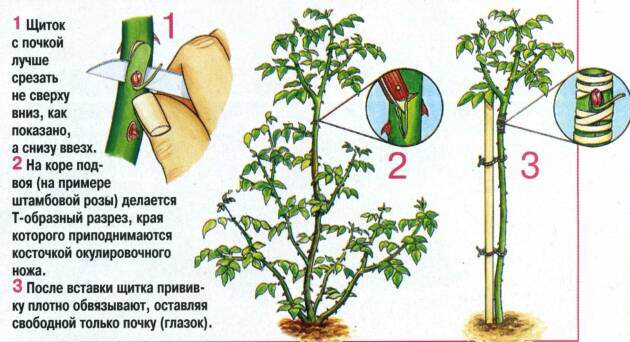

Rose grafting
Operating procedure:
- During the day, the stock is spilled a lot, so that it has enough water and active sap flow begins.
- Next, we take the cutting and separate the thorns and leaves. But we leave the petioles on the shoot.
- We make an incision with a knife.
- Next, you need to separate the remnants of the bark.
- A small kidney remains.
- We find the place where we will plant our peephole. This place should coincide with the separation of the first root.
- We rake off all the soil to the first root, and there we make an incision. Usually the bark separates so well that it turns white.
- We are trying to separate the bark.
- In this resulting feeder you need to carefully insert the remnants of the root.
- Cut off the remains.
- Next, you need to tie this place with tape.
- Further, the plant is slightly covered with earth.
- After 2 weeks, if this kidney takes root, it will turn green. And if it doesn't take root, it will remain black.
Pruning
For polyanthus roses, the following types of pruning are required:
- Spring... It involves the removal of frostbitten and broken branches after winter. Healthy shoots are cut to a third of the length, leaving 3-5 buds. The bush is given a beautiful shape.
- Summer... Remove dried branches.Do not forget to remove faded flowers in time, do not allow the formation of seed pods. This procedure will prolong the flowering period and make it more abundant.
- Autumn... The bushes are examined and diseased shoots are removed.
Rose seed sowing algorithm
When grown from a seed, a polyanthus rose retains all the characteristics of a parent bush. However, the most important thing when growing is to choose the right seeds. They must be healthy and strong. Gardeners rarely trust purchased seeds, so they are most often harvested from shrubs on their own or a neighbor's plot. This is where the growing process begins.
The seeds of the polyanthus rose are considered to be tightly similar, so they are planted as early as possible. It is necessary to start the sowing procedure in January-early February. In this case, the seedling will have time to grow strong enough before being transferred to the open ground.
Step 1: collecting seeds
It is necessary to select seeds in August, when the bulk of the buds have already faded. For this you need:
- find not fully ripe seed pods (with a slight blush);
- carefully open the skin so as not to injure the seeds;
- pour out the seeds and free them from the pieces of pulp.
The resulting seeds are examined and only the strongest are selected. Rotten and dried out planting material will not work. Immediately after selection, the seeds are washed in potassium permanganate to disinfect them.
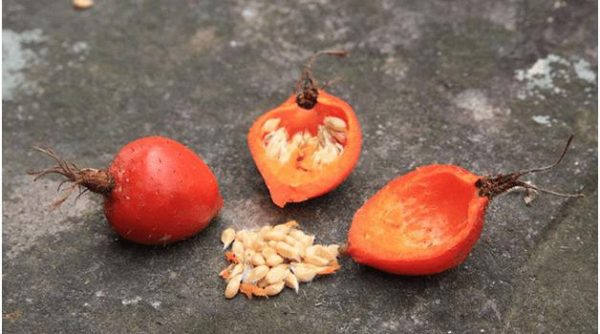

Seed box opening
Step 2: stratification
The seed must undergo a stratification (interlayering) procedure. This process can be carried out both in natural and artificial conditions.
Table 2. Differences between natural and artificial stratification.
| Process variation | Materials used | Implementation principles |
| Natural | - wet soil on the site; - a layer of snow. | It is characterized by independent germination almost without human intervention. 1. In autumn, the seeds fall into the ground and go to a shallow depth. 2. With the beginning of winter, the soil is covered with a layer of snow, which lays on the seeds until spring. 3. Comfortable conditions for germination are created in the ground - suitable humidity and temperature. 4. With the arrival of spring, roses sprout without any problems. |
| Artificial | - cotton cloth / napkins / cotton swabs; - you can take filters from the coffee machine (it is easier to see whitish seeds on dark material); - hydrogen peroxide; - cling film or plastic bag. | 1. A cloth or cotton swabs are abundantly moistened in peroxide, seeds are spread on them. 2. From above the material is covered with another layer of napkin or cloth. 3. The prepared interlayer is placed in a bag or wrapped in a film so that the moisture does not evaporate. Each package is signed: they put the number and name of the variety. 4. Packages are put in a vegetable box of the refrigerator with a temperature not less than +4 ... +5 degrees. The seeds are regularly removed and inspected. If mold has formed, the seeds are replaced with new ones. As a rule, the first shoots appear 2 months after the start of stratification. |
There is another method of harvesting seeds. In this case, they will not have to be taken out of the cold and transplanted into pots. It looks like this:
- Rose seeds are poured into a cup and poured over with settled water. They remain in the plate for 14-18 days.
- Prepare small pots with fertile moist soil. The seeds are drowned in it at a depth of 5-7 mm. From above, the soil is covered with a layer of perlite 1 cm wide.
- Each pot is covered with glass or cling film. The finished containers are removed to the refrigerator or basement.
- For the next 1.5-2 months, check for moldy seeds and moisten the soil from the sprayer as it dries.
After the first sprouts emerge, the pots are transferred to a sunny warm place with an air temperature of up to 18 degrees. At the same time, direct sunlight should not fall on the sprouts, the lighting should be diffused. When the sprouts are strong, they can be moved into the ground on the site.
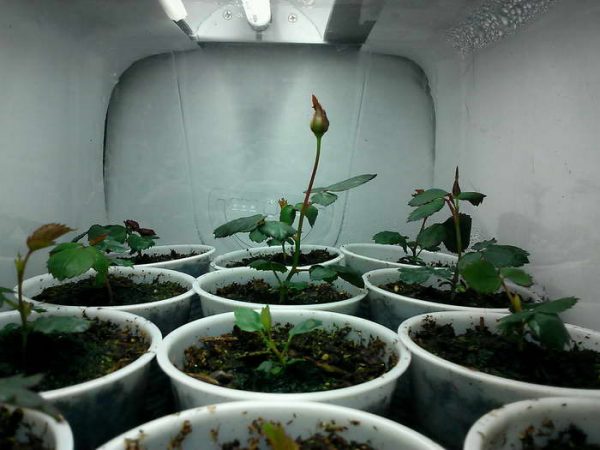

Prepared seedlings in the refrigerator
Step 3: preparing for sowing
Before the sowing process, it is necessary to prepare containers and soil. Suitable containers for sowing:
- common wide container for seedlings or cassettes with individual cells;
- small pots for individual planting;
- peat tablets that provide additional nutrition for the seeds.
If you sow roses in a common container, you cannot do without picking in the future. This process can injure the fragile roots of the plant, so gardeners recommend using individual containers. In this case, the grown flowers can be simply poured into a larger pot. You can read more about picking in our article.
As far as soil is concerned, polyanthus roses will work with any generic store-bought seedling composition.
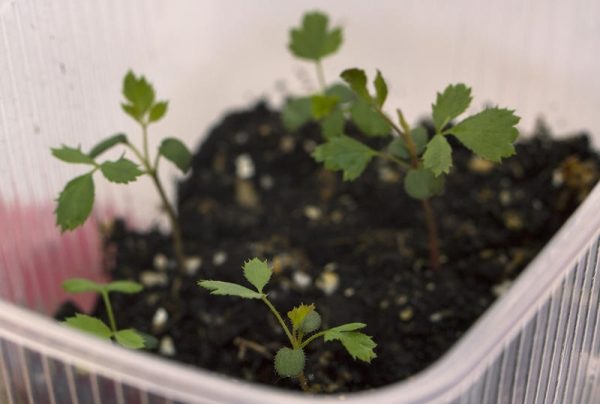

Young sprouts of polyanthus rose
Seedling boxes prices
seedling boxes
Step 4: plant the seeds
The seeds germinated after stratification are immediately planted in the soil. So that in the process of ripening the flowers do not begin to rot, the surface of the soil must be covered with a layer of perlite. The component is used as a prophylaxis for "black leg" - a common flower disease.
The landing algorithm will be as follows:
- The seeds are placed one at a time in a cell or pot. If a container is used, the wells are made at a distance of 3 cm from each other.
- The planting material is deepened by 0.5 cm. You can spread the seeds on the surface of the soil and cover them with a layer of loose soil.
- After sowing, the soil is sprayed with settled water. The pots are covered with plastic wrap or covered with a transparent lid. Crops are regularly ventilated, moistened and removed condensation.
- As soon as the seedlings in the common container become cramped, they are transplanted into separate jars.
In about a month, the first shoots should come out. As soon as they hatch, the film is removed.
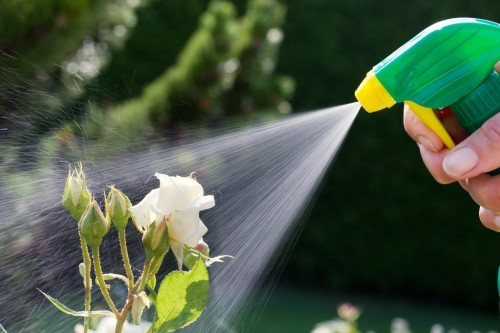

The rose loves moisture, so it is regularly sprayed
Characteristic
The bush is low, up to 50 cm in height, strongly branched. The flowers are simple or double, small in size, up to 4 cm in diameter. Most often red or pink, less often white. They are odorless. Flowers are collected in large inflorescences, in one brush there can be up to 50 buds.
The leaves are small, with ciliated stipules, glossy, dark green.
In the rainy, cool season, flowers can get sick with powdery mildew.
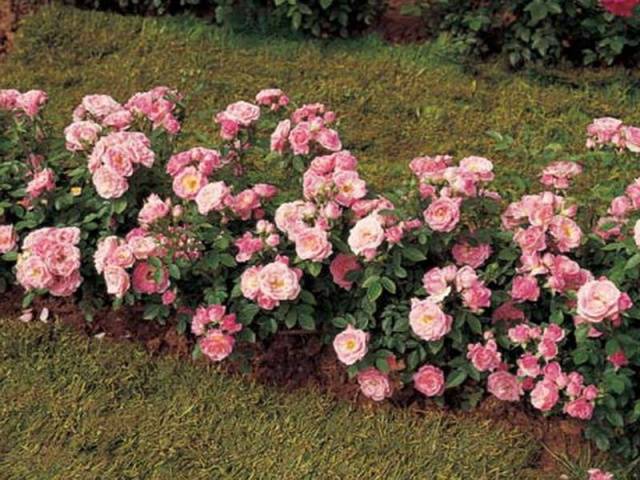

How to properly collect planting material
Usually, seed for propagation begins to collect from mid-summer to early fall. The seed boxes should turn yellow or reddish during this period. It is not recommended to use overripe seeds for sowing. Experienced flower growers advise using boxes on which there is a slight blush to collect the seed. In their opinion and experience, "babies" from immature testes are better than from fully ripe ones.
To extract the seed, you need to carefully cut the box in two. Take care not to damage the grain, remove it from the pulp. It is normal for the extracted kernels to have a different shape and color than the purchased ones.
In the modern world of online commerce, the easiest way to buy any, even the rarest goods, in specialized online stores Therefore, most often flower growers are interested in the question of how to plant roses from China, the seeds of which are offered in large quantities by the Aliexrpess trading platform. The minimum cost of planting material, a huge number of varieties and species, fast delivery - all these advantages make the purchase very profitable. And if you want to diversify as much as possible the number of species and varieties of garden roses in your rose garden, then it is difficult to think of the best way to do this.
There really is no difference in how to plant rose seeds from China or Holland. This is the most common seed obtained in a completely traditional way. Therefore, the sowing rules are exactly the same as for other flower crops with small seeds.


But how to plant roses correctly, you can learn from the proposed material.Pay attention to the pre-sowing preparation - it plays a critical role in the success of the entire agrotechnical operation.
If the itching of gardening is so strong that you can't wait to start experimenting, then you can start planting now. Usually we plant roses at home in a common container filled with a nutrient mixture. A pick is carried out only after the seedlings reach the age of 60 days.
Before planting a rose with seeds at home, you need to do some preliminary preparation. It includes stratification, soaking in 3% hydrogen peroxide and sowing itself. We will talk about all these stages further.
Also, before planting rose seeds correctly, you need to prepare suitable containers and soil. Note that it is very important to rule out fungal infections. Therefore, the containers should be thoroughly rinsed with baking soda, and the finished soil should be calcined in the oven for at least 3 hours in a row. add the required amount of Fitosporin powder before planting.
The first stage of seed preparation is stratification. You should not give in to all sorts of advice that you need to soak the seeds first, then dry them, and only then spread them out on a napkin, roll everything up and put them in the refrigerator. In fact, everything is much simpler. As soon as you have your next packet of rose seeds, send it to the very bottom of the refrigerator.
Believe me - there is no difference in the methods of stratification. This technique consists only in the prolonged exposure to negative temperature conditions on the seed. After suffering stress, the seeds hatch quickly after entering the nutrient soil and give a high percentage of germination.
After the end of the stratification period (and it lasts about 20 days), the seeds should be soaked for 6 hours in 3% hydrogen peroxide. This technique also increases germination. You can replace the peroxide with Epin.
The preparation of containers is that they should be soaked for a day in a strong solution of bleach for complete disinfection. Then rinse with hot water with baking soda or soda ash. Dry well before use. These can be plastic and wooden boxes with sufficient drainage holes.
Soil preparation for planting is briefly described in the article above. We mix one part of the sod land, humus and river sifted sand. We send everything to the oven for 3-4 hours. then fill with boiling potassium permanganate solution. After cooling down, mix with a fungicidal preparation and a matchbox of mineral fertilizers for flowering crops. Mix and fill the boxes.
And now a few words about the correct sowing of a rose with seeds, how it is carried out and how it differs. So, lighting is required for seeds to germinate. The more sunlight hits the seeds, the faster they wake up and start growing. Therefore, sowing is carried out on the surface of the soil without sprinkling earth on top.
There is a very simple trick: sowing rose seeds in the snow. To do this, first, the container is filled with soil. It thickens. No need to water. A layer of snow is laid on top of it (about 5 cm thick). Spread the seeds evenly over the snow cover. We cover with transparent film or glass. We put on the windowsill lit by the sun. The snow will melt and moisturize the seeds. This speeds up the germination process.
Watering is not necessary until the gatherings appear completely. When the ground is dry, you can water the first times with a pipette or with a disposable syringe. Watch it so that you don't break fragile seedlings.
Proper care of seedlings of a rose grown from seed is very laborious. It is advisable not to remove the film cover for as long as possible after the emergence of seedlings. Then there must be a hardening period.Gradually open the greenhouse for a short period of time until the seedlings get used to the room humidity conditions.
Watering and feeding should be done very carefully, only as needed. Excessive soil moisture leads to the formation of a black leg. All grown seedlings can die from this fungal disease. Meanwhile, the reason for this is thickened shoots. Therefore, when the first signs of a black leg appear, the seedlings should be thinned out and the soil should be covered with a layer of wood ash of 1 - 1.5 cm.
The pick is carried out at the age of 60 days from the emergence of shoots. By this time, the seedlings become strong. Make the pick very carefully, taking care not to damage the root system. After transplanting into separate pots, cover them with plastic wrap.
Hardening rose seedlings when growing from seeds should be carried out several weeks before planting in open ground. For this, the pots are taken out into fresh air, depending on the temperature, for a period of 30 to 60 minutes. Gradually add half an hour every day.
Seedling care immediately after planting
At first, the seeds only need enough heat and moisture. The temperature regime for them should not be higher or lower than + 140C. You do not need to open a mini greenhouse. It should be kept closed throughout this growing season. This will allow the plants to grow and develop normally.
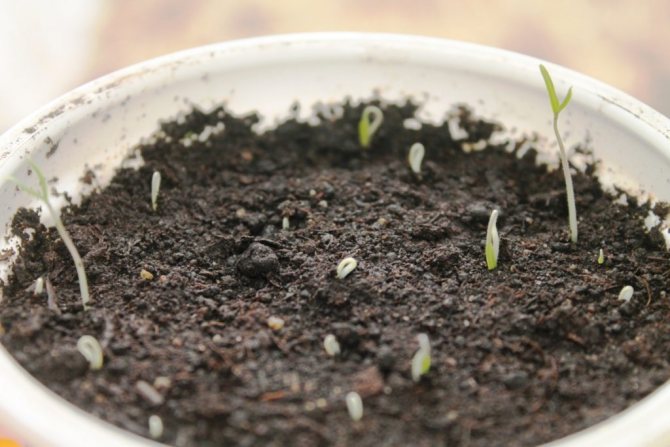

First shoots
At this point, you only need to ensure that the soil does not dry out. Humidification is carried out with a spray bottle. Excess moisture will drain into the pallet. It is also important to ensure that there is no stagnation of moisture in it, which can lead to a disease of young seedlings called black leg.
back to menu ↑
See also: Beans: a description of the beneficial properties for our health, possible harm to the body of women and men + Reviews
Choosing a seat for landing
The area on which the planting of germinated grains is supposed to be well lit, protected from the winds.
back to menu ↑
See also: We filter water in the country: the choice of effective equipment, flow, main and other filters + Reviews
How to plant young roses correctly
Planting holes should be wide and deep enough. So that the root system of the plant enters into them and settles down freely, without being damaged.
- When using the closed method (where the root system is covered with a layer of earth), the bush simply rolls over from the pot to the hole.
- The open root system should be straightened, straightened, positioned so that the roots do not bend, do not press down.
- The distance between the planting pits should be about 55 cm.If you plan to organize a hedge, this gap can be slightly reduced, for example, to 35-40 cm.
- After planting, the bushes are well watered.
It is very important to ensure that the soil is constantly moistened until all the seedlings are finally rooted in the area.
back to menu ↑
See also: Planting and growing pears: description, types, watering, fertilizing, pruning and other subtleties of tree care (25 Photos & Videos) + Reviews
Mulching
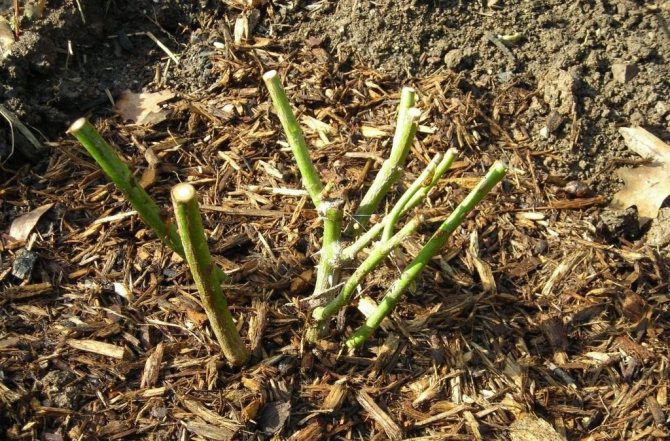

To protect young plants from overheating, accidental mechanical damage, to reduce the amount of watering, you need to mulch the site
Suitable for this:
- sawdust
- cut dry grass
- needles
- straw
Mulching will save the grower from frequent weeding and loosening of the soil. This means that it will reduce the risk of accidental damage to the root system and stems.
back to menu ↑
See also: Morning glory: description, popular varieties, growing from seeds, planting and care (50+ Photos & Videos) + Reviews
Watering
Young rose seedlings need plenty of moisture. Do not over-water or over-water them. Drying of the soil is also not allowed.
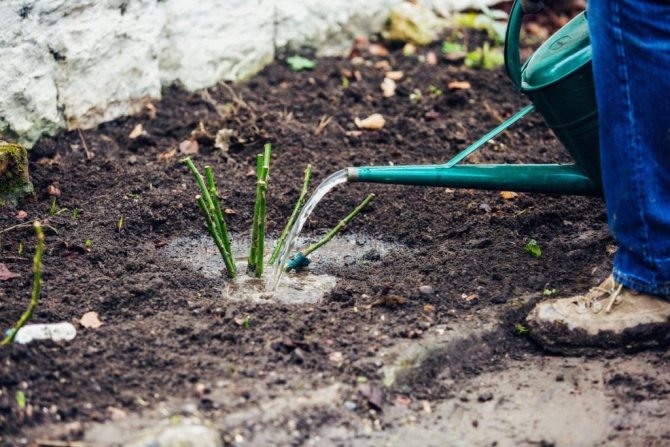

Watering the plant
The frequency of watering in dry weather should be at least 1-2 times every 3 days. You need to irrigate in the morning and evening. On cloudy, cool days, reduce watering frequency to a minimum or stop altogether.
back to menu ↑
See also: Blind area around the house: views, device, schematic drawings, instructions on how to do it yourself (30 Photos & Videos) + Reviews
Top dressing
You need to feed the seedlings with special complex fertilizers for roses. The frequency of dressings is no more than 2 times a month. Fertilizers are applied foliarly (under foliage).
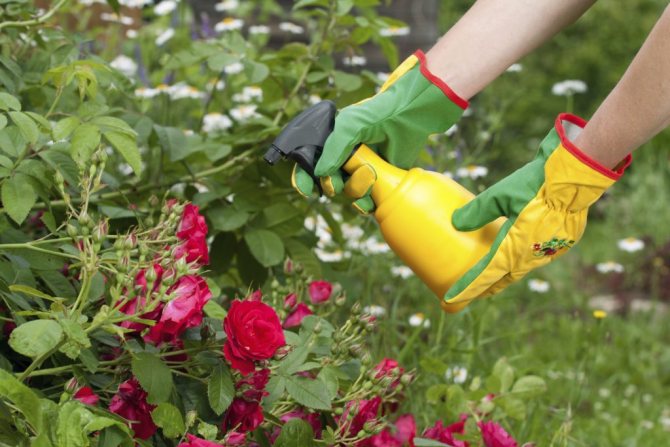

Fertilizing process
The procedure will not take much time, but roses will grow better, faster, healthier.... When flowering, it will affect the abundance of inflorescence formation, brightness and duration. You need to feed plants grown from seeds with organic matter. Will not spoil the nature of the soil and mineral fertilizers. Roses always respond well and respond to mulch with humus or fermented manure.
Seed planting workshop
The optimal time for sowing rose seeds is February.
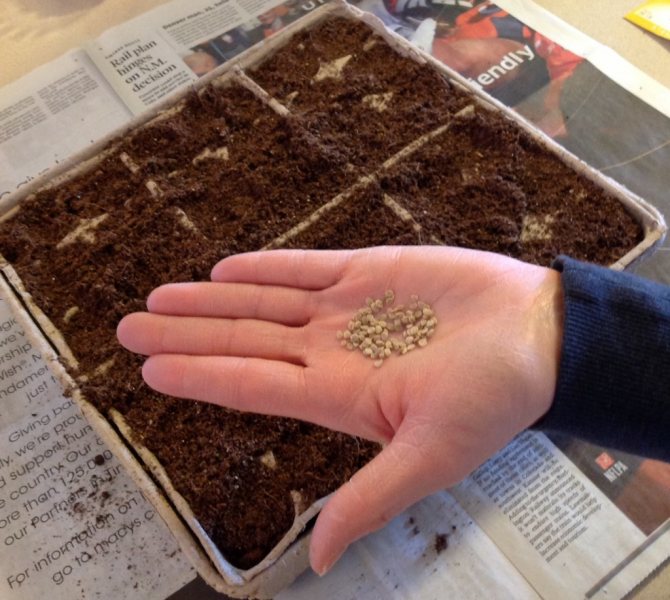

After the stratification procedure, the germinated seeds must be planted in the ground.
Step one
- Tanks for planting and soil are being prepared.
- For this, plastic boxes are quite suitable.
- The first is the drainage material, on top of it is fertile soil.
- The bottom of the box should have several punctured holes so that excess moisture can drain through them into the pallet.
Step two
- After planting the seeds, the soil is watered with a growth stimulant.
- Well suited for this "Kornevin", Fitospirin-M "and" Heteroauxin ".
- This will accelerate the emergence of the first shoots, activates plant growth.
Step three
- A layer of sand or vermiculite is laid on top (on a layer of soil).
Step five
- When everything is done, the box is covered with a lid (also made of plastic) or cellophane.
- Leave in this state until the first shoots appear.
- The container with seeds should be placed in a relatively warm place with good access to natural light.
- It is very important that there is no draft in the room where they are stored.
The germination of the first shoots should be expected in a month. You need to be prepared for the fact that, for example, about 5 germinated seeds will sprout out of 12. This is normal, there is no need to be afraid especially about this. If you need more seedlings for planting in open ground, then you will need to sow more of them.
back to menu ↑
See also: Homemade rose in a pot: how to care for it after buying it at home? (20+ Photos & Videos) + Reviews
When and how to plant?
Plants are usually planted in spring (April, May).
First you need to dig a deep hole.
Then you need to prepare:
- the plant is placed in a bucket for 10 minutes;
- live microorganisms are added to the bucket;
- biological growth promoters are also added.
The hole must be dug so that the root collar is immersed 5 cm down.
Then you need to cut the plant by 10 cm. Now we lower it into the hole and bury it. After that, water abundantly. We huddle the plant on top so that the sprouts are all closed.
Outdoor seedling care
A young polyanthus rose, despite its unpretentiousness, requires care. The procedures necessary for full development are presented in the table.
Table 3. Care of a young polyanthus rose in the garden.
| Procedure | Features of the |
| Watering | This rose variety loves dampness. In dry weather, water every other day. A large volume of water is poured into one hole in the evening or in the morning. In rainy, cool weather, you do not need to water the flowers. |
| Mulching | Mulching retains moisture in the soil and protects the plant from the damaging effects of the sun. It also helps to get rid of frequent loosening and weeding. The procedure is carried out with any natural material: - hay; - needles; - dry grass; - wood shavings. The layer of material is laid close to the trunk of the bush. It turns out a circle with a diameter of about 20-30 cm. Plants react especially well to mulching with rotted grass. You need to pour in no more than 1 bucket per 1 sq. m. per year, so as not to "overfeed" the shrub. |
| Fertilizer | Roses require periodic feeding. During the flowering period, they are held twice a month, then once every 30/60 days. The easiest method of mineralization is to spray the rose leaves with nutrients. From this, the flowers become brighter, and the greenery is more abundant. For sub-root fertilization, manure mixed in a liquid is used in a ratio of 20: 1. |
| Pruning | At the end of the flowering season, brushes with dried inflorescences are cut off from the shrub. There is no need to prune the branches, as the shrub is compact and does not grow. However, in early spring, sanitization will be required: removal of frozen and diseased branches, if any. |
| Preparing for winter | Each plant must be covered for the winter. Features of the process depend on the area of growth: 1. Middle zone of Russia, temperate climate. At the bush, the top is cut off to half, and the root collar is covered with earth in the form of a 30-centimeter mound. 2. Northern region or winter without snow. Leaves are poured under the cut bush or a layer of straw is placed. Cover the top with a protective material. After the snow melts, the protection is removed. If there is no frost at night, the root collar can be freed from the earthen mound. |
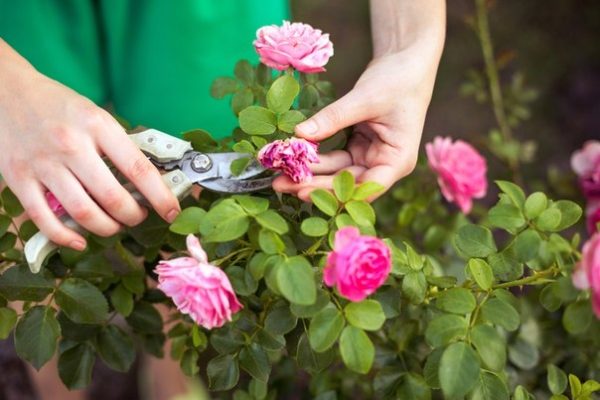

Pruning a withered flower
If stratification is not done?
If this procedure is ignored, a lot of growth inhibitors are produced in the seed. This will stop the sprouting process for a very long time. Simply put, the germination of seeds can take 1-2 years, provided that the seed does not die during this time.
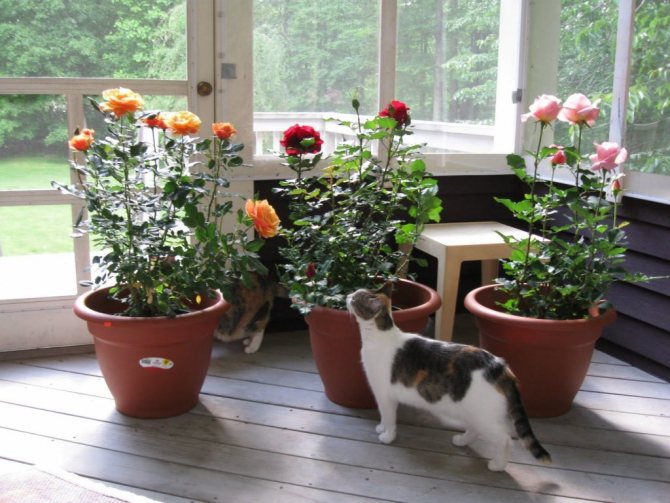

Large roses grown in a pot
This applies to those varieties of crops that are adapted to the climatic conditions where they are planned to be planted: to temperature, humidity, type of soil. Those varieties in which these indicators are stable and additional requirements for germination rules are not required can multiply in any season.
If we are talking about flower crops, then this applies mainly to perennials, which include roses. In addition to them, cold stratification is required: bellflower varieties, buttercups, honeysuckle, magnolia, primrose and others.
Stratification at home is easy... Knowing the rules for its implementation and the sequence of actions - even the most inexperienced florist can do this.
back to menu ↑
See also: Saxifrage: description, types and varieties, reproduction, growing from seeds, planting in open ground, care (110+ Photos & Videos) + Reviews
Landing
Polyanthus roses will grow and bloom in any conditions, but in order to get a bright abundant flowering of the bushes, as in the photo, you need to know the rules of planting and care.
Bushes of polyanthus roses are not afraid of high acidity of the soil, but these flowers develop best on loose, well-fertilized soil with neutral acidity.
The best place to plant polyanthus rose bushes is sunny and well-ventilated. These roses grow well in partial shade, but the branches of the bushes can stretch and sag under the weight of flowering brushes. In this case, it is necessary to make supports for the bushes.
The size of the planting hole is determined based on the size of the root flower system. The roots of the bushes should be located in it freely, you cannot fold and bend them.
Before planting the bushes, they bring into the planting hole:
- Ripe humus;
- A glass of wood ash;
- Complex of microelements;
- Sand.
Humus must be checked for fungal spores. If a white bloom is noticeable on some parts of the substrate, such humus must be dried well in the sun before use, only then it can be used as a fertilizer for growing flowers.
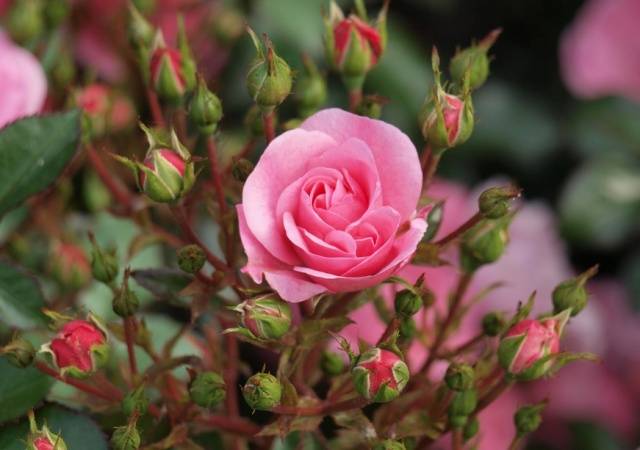

Complex fertilizers, especially nitrogen fertilizers, must be applied strictly according to the instructions. Excess nitrogen in the soil can harm flowers. It is advisable to choose fertilizers marked "for roses".
The best varieties
Among the most popular and well-proven varieties of polyanthus rose, plant growers note: Orange Triumph, Masquerade, Iceberg, Angel Wings, Spartak.


Orange Triumph
This variety of polyanthus rose has an intensive growth rate, its height is 60-90 centimeters. The bush forms luxurious double flowers 3-5 centimeters in diameter, which are collected in chic brushes, green leaf plates with a glossy surface. There are almost 60 petals in one flower, their color is salmon red with an orange sheen. The rose looks quite elegant, up to 50 roses open at the same time on one shoot.
Masquerade
The bush stands out for its tall stature and resistance to major ailments. The height of the plant does not exceed 70 centimeters, the color of the leaf mass is dark green. Roses are formed in large sizes, they are friable and with a pleasant scent. Up to 5 pieces are formed in one inflorescence. The flowering of the polyanthus rose is long and plentiful, the color is first yellow, and then pale crimson.


Iceberg
The plant belongs to the bush type, its height is 60-80 centimeters, the flowers are 5-7 centimeters in diameter. Polyanthus rose attracts attention with its snow-white flowers, which last for a long time, both on the bush and in the cut. Shoots are erect, on light green leaf plates with a glossy surface. The variety differs in multiple flowering, from July to September.
Angel wings
The bush (30 centimeters in height) has a neat appearance, its flowers reach 5-6 centimeters in diameter, they are painted in a light pink color. There are several varieties: non-double, where the number of petals in the flowers is 10-15 pieces, and terry - up to 25 pieces. One brush can contain up to 15 highly fragrant roses. Flowering is almost continuous, until the onset of cold weather.
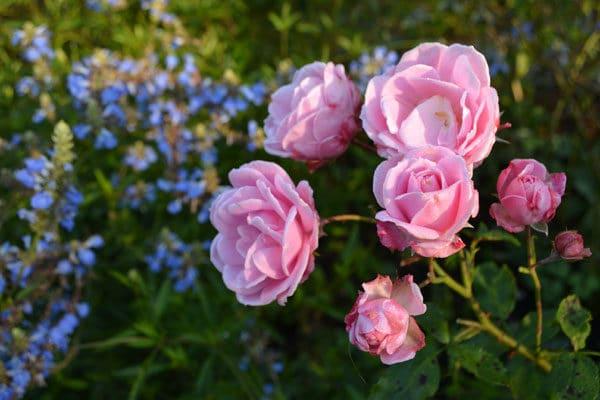

The Angel Wings rose variety can be bred both by seed and by cuttings. They choose it mainly for creating spectacular group compositions. They look especially advantageous when planting on lawns, along roadsides, sidewalks. The plant, due to its high decorative characteristics, fits perfectly into the design of terraces, balconies and verandas.
Spartacus
Polyanthus rose belongs to tall plants, its height is almost 80 centimeters. A distinctive feature of the Spartak variety is its very large flowers, which also stand out for their beautiful shape and red color. There are also specimens with orange buds, which makes the bush even more spectacular.
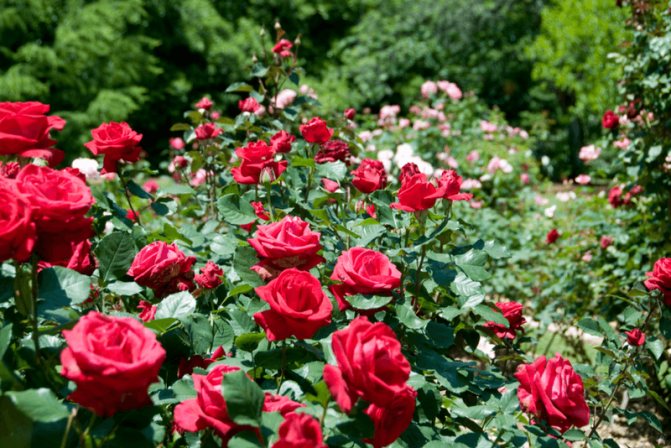

Polyanthus rose is truly a luxurious and graceful plant. Bushes are actively used in landscape design, they can be planted as individual garden decorations, or in combination with other flower crops, they look especially harmonious with ears of grasses. The main thing is to adhere to proper agricultural techniques when growing rose bushes and not ignore methods of protection from low temperatures.
Important nuances
If small seedlings can feel great in a small container, then after they reach about three weeks, it becomes necessary to "expand the living space" for growing flowers. It is recommended to choose a medium-sized container, and carefully place the sprouts in it, at the same time thinning.
From sunlight - direct and aggressive, young shoots must be protected. Watering the growth of a polyanthus rose is necessary as the top layer of the soil dries up. And fertilizers containing potassium, phosphorus and nitrogen will help plants grow stronger and develop fully faster. But how the Monstrose daisy is grown from seeds is described in great detail in this article.
Outdoor cultivation
Experienced gardeners usually exclude artificial stratification of seeds in the refrigerator, preferring to carry out this procedure immediately in natural conditions.However, if you have little seed, then it is better not to risk it, but to carry out the procedure of stratification and subsequent germination in a traditional way.
If you nevertheless decide to sow the material directly into the ground, then prepare trenches for this in advance. The soil in the trenches should be fairly loose and fertile. The seeds are laid in trenches, and sprinkled with earth on top with a layer of about half a centimeter. All these works are carried out in the fall.
On video growing roses in the open field:
If the weather is dry, then the seed trench must be sprayed and covered with foil to ensure optimal moisture.
If things are heading towards winter, and it becomes cold, it is better to cover the garden with dry leaves of spruce branches, straw or hay. This shelter can be removed as early as April, when the probability of snow and frost becomes minimal, and the sun is already warming the earth well. If you live in northern latitudes, then after removing the shelter, it is recommended to set up a small greenhouse with a plastic top over the garden bed, which will protect the tender seedlings from possible natural incidents.
It should be noted that polyanthus roses, which were grown immediately in the garden, will be more viable, strong and lush.
What nuances you need to know in order to provide proper care for the polyanthus rose.
Be sure to pay attention to the removal of dead inflorescences. If you do not do this, the rest of the buds may not have enough nutrients for full flowering.
The plant needs a fairly abundant watering. Moreover, the polyanthus rose is not afraid of even a fair waterlogging of the soil.
In general, the plant is resistant to rot and pest infestation. The usual treatment of seeds with peroxide is sufficient for the necessary protection of an adult plant from microbes and diseases. In the fall, the polyanthus rose needs pruning. But how landscaping with roses and conifers is done, and how good it looks, the photo from the article will help to understand.
We examined the features of growing a polyanthus rose from seeds. As you have seen, there are no special intricacies in the procedure for preparing seeds, planting and subsequent care. If you follow the simple recommendations given in the article, you can grow strong healthy plants that will delight you with their lush flowering for a long time.
Some gardeners hesitate to plant roses on their site, fearing the difficulties of caring for a capricious beauty. But some varieties of roses are undemanding, do not require shelter for the winter, caring for them is simple and accessible to everyone.
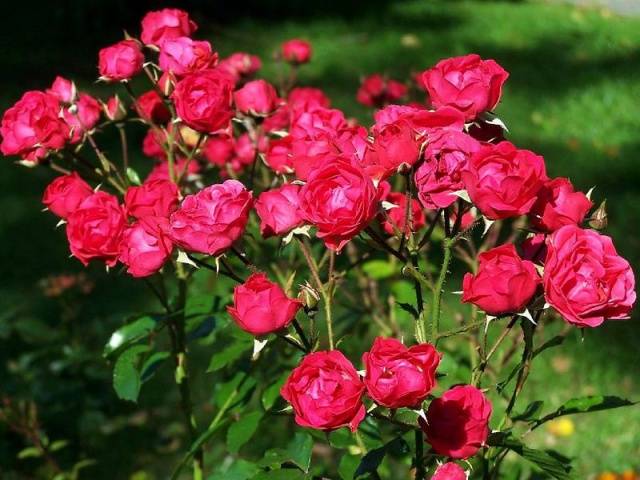

Characteristics of species and varieties of crops
Hybrid tea roses
Polyanthus rose varieties are a large group that has many characteristics that differ from each other, but at the same time have the same origin and common features.
- The Fairyland polyanthus rose was obtained by Harkness in 1977 in the UK and registered in 1980. The height of the bush reaches 75 cm, and the width is slightly more than 1 m. A distinctive feature of the variety is the rosette-shaped flowers of pale pink color. The aroma emanating from the flowers is light and delicate.
You can find this variety under the names Harlayalong, ground cover rose, and spray rose.
- The Lady Reading variety was bred by Van Cleef in 1921. The height of the bush is slightly more than 1 m, the width also reaches 1 m. The double flowers have a rich red color.
- The rose bush of the Marjorie Fair variety reaches 1.3 m in height and width. The flowers are bright crimson with a white center.


Lady reading
It is sometimes sold under the name Red Ballerina as well as Red Yesterday.
- The old polyanthous rose variety Mevrouw Nathalie Nypels was obtained in 1919 in the Netherlands by an unknown breeder. The name, presumably, is a dedication to an unknown lady named Natalie.
The height of the bush is no more than 75 cm, and the width reaches 60 cm. The flowers are semi-double, pink. The aroma is sweet.
Some catalogs assign the variety to another group of Rosaceae - Floribunda.
- Orange Triumpf is a variety developed in Germany in 1937 by Wilhelm Cordes II of the famous "pink" dynasty of Cordes.
Rose Orange Triumph can reach a height of 1 m, and a width of 70-75 cm. Double flowers have a rich red color. There is no particular aroma.
- Rose The Fairy was obtained in 1932 in the UK by Ann Benthol. On the basis of this unique variety, several more varieties were bred.
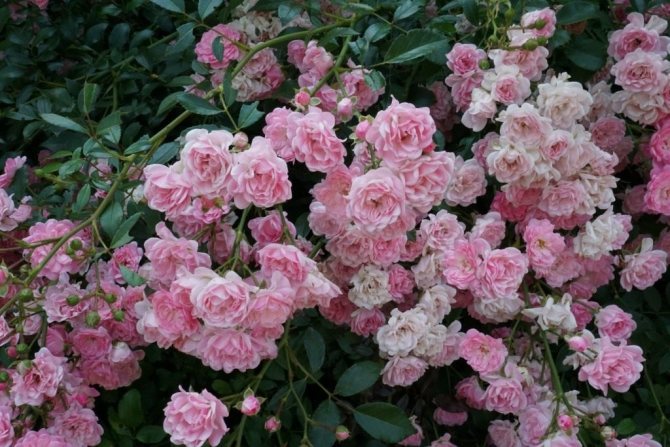

Rose The Fairy
The rose differs from other varieties by its unpretentiousness and the absence of periods of rest between flowering. For this reason, the bushes are often used as a ground cover plant. The variety is especially suitable for beginner gardeners.
The height of the bush and its width range from 60 to 90 cm. The flowers of the rose are rosette-shaped, the color is pink. The variety has a light pleasant aroma.
- Kubinochka is a variety obtained by Vera Nikolaevna Klimenko in the Crimea in 1959. The flowers are bright pink, the center is yellow. The rose has a classic scent of polyanthus rose.
How to shelter for the winter
In October, when the temperature drops to 0 ° C, they begin to cover the rose garden. The base of the bushes is sprinkled with shavings or large sawdust, sometimes foam crumbs are used for this purpose.
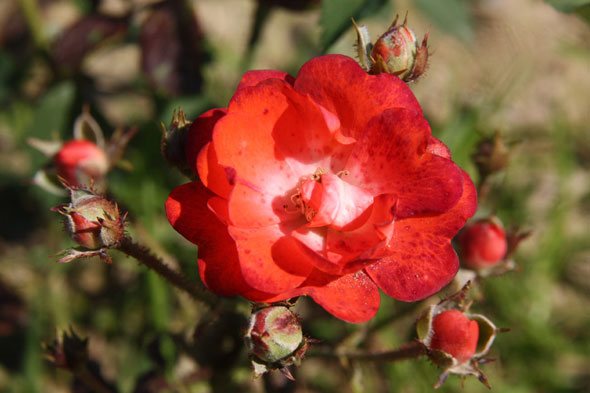

A frame made of metal or boards is installed over the bushes, on which an agrotechnical cloth is thrown. Polyethylene is not used, moisture accumulates under it.
In winter, it is useful to throw snow over the rose garden.
Species that can be grown from seeds
To grow the varieties of roses below, you can use the "kids" collected on your site, take from other gardeners or buy in the online store. As mentioned above, hybrid varieties cannot be grown by seed. Only a few varieties can be propagated, which are popular with many gardeners.
back to menu ↑
See also: How to create beautiful flower gardens and flower beds in the country with your own hands? (220 fresh photos and video ideas) + Reviews
Angel wings
Angel Wings - Chinese varieties
Unpretentious to care. It takes root well, grows, blooms in open ground, in the house and in the greenhouse. When growing this variety, the seeds do not need to be stratified. Here, the seed propagation technique is much simpler:
- To grow the Angel Wings rose from seeds, it is enough to place the planting material in pots with a substrate. Necessarily moisturized and loosened.
- After planting the seed, slightly compact the soil, cover the pots with a lid or a plastic bag.
- The temperature in the room where they are placed should be + 160C.
After 2.5 months, you can expect not only the first shoots, but also the flowering itself.
back to menu ↑
See also: Popular plants for landscaping and decorating a nursery and kindergarten premises. Recommended and Banned (25 Photos & Videos) + Reviews
Polyanthus rose
The variety is low (about 50 cm in height). Refers to winter-hardy varieties. Can be grown in gardens, open areas, greenhouses.
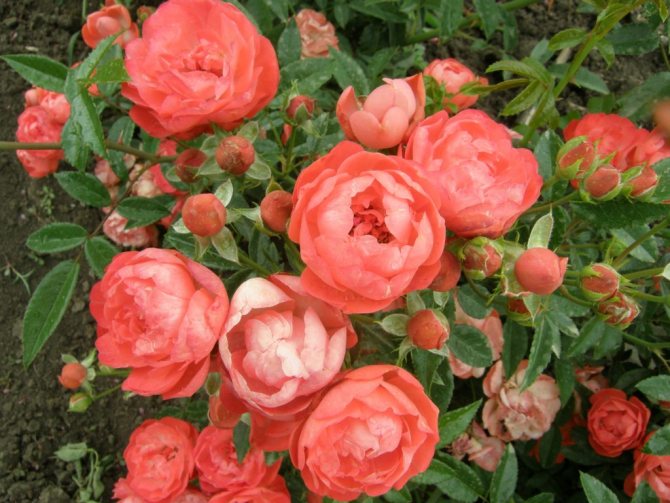

Variety Morsdag
The Polyanthus variety is considered the leader in terms of flowering density. About 100 buds can form on one adult bush. Prefers open areas with ample light.
Some growers grow it at home - on windowsills. This variety requires stratification when it comes to growing a plant from grains. Frost resistant. Polyanthus rose blooms for a long time - all summer and even in autumn. During flowering, the bush is generously covered with medium-sized, but bright inflorescences.
Valued by gardeners for:
- high decorativeness
- lack of thorns
- unpretentiousness to soil
- shade tolerance
- not exacting to care
They use polyanthus rose to decorate flower beds, flower beds, ridges, borders, rock gardens. This variety can be grown in an apartment in a pot or container.
back to menu ↑
See also: Lobelia: description, planting and care, when it should be sown, description of varieties (50 Photos & Videos) + Reviews
Lavatera garden
Herbaceous plant from the Malvov family. The common name is wild rose or hautma. There are approximately 25 subspecies. It is not demanding on the composition of the soil, but prefers to grow in regions with a warm climate. Resistant to heat, drought, not afraid of the wind.
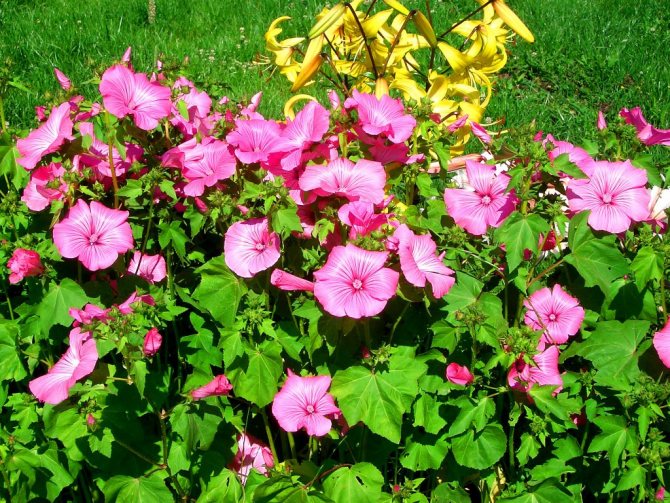

Lavatera Three Months
Tall Lavantera needs additionally installed supports and trellis. It is necessary to plant the plant in well-lit areas; in more shaded inflorescences, the inflorescences may not fully open, which affects the beauty of flowering.
Mature bushes reach 1.5 m in height. The leaf is alternate lobed, covered with hairs along with the stem. The flowers are large, up to 10 cm in diameter. Color: yellow, crimson, white, red, pink. They can grow singly, in racemose inflorescences, or in several pieces.
back to menu ↑
Read also: Bulbous Flowers Catalog: Description 21 Varieties, for growing in the open field and at home (65 Photos & Videos) + Reviews
Rejuvenated (stone rose)
This variety belongs to those rare types of flowers that, giving joy to people, do not require practically anything in return.... Belongs to the fatty family, has about 40 varieties. The leaf is thick, fleshy, collected in a rosette adjacent to the soil, usually round in shape.
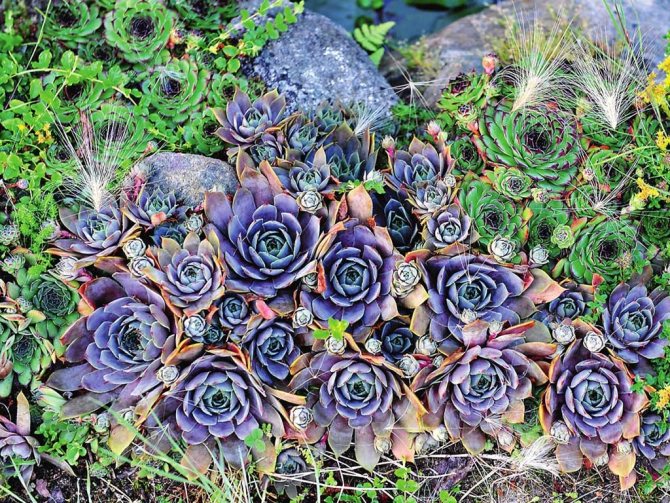

It was rejuvenated. It is also called hare cabbage or tenacious.
It blooms only once a season, but rejuvenated is appreciated not for its flowers, but for its forms, appearance. The larger the leaf, the more beautiful the plant. Florists and gardeners love rejuvenating for a bright green color that does not change throughout the growing season. Resistant to frost, not whimsical to the choice of soil, not demanding to care.
back to menu ↑
See also: Perennial lupins: description of the plant, growing from seeds, planting in open ground and caring for them (50+ Photos & Videos) + Reviews
Stock-rose (Mallow)
A variety that is also grown from seed. Sowing should be carried out in June directly into the open ground. The rose seed does not need to be stratified. Here it is important to observe the intermediate distance between future bushes, it should be about 20 cm.
Usually the seeds of this rose variety are sown in the month of June. The first shoots will appear in 2 weeks. If you need to get seedlings earlier, then they can be sown in February in greenhouse conditions.
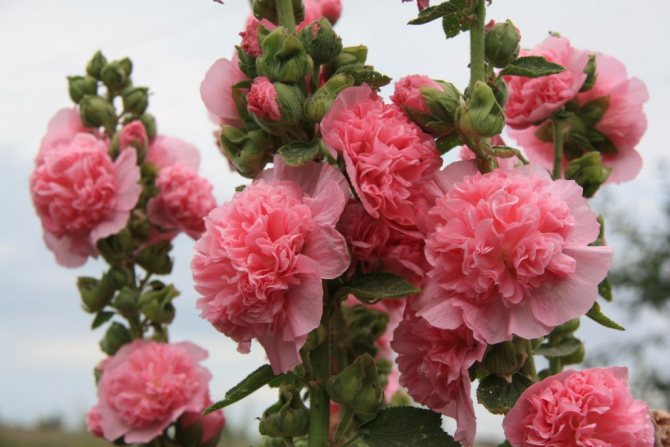

Malva variety
Sowing should not be done as usual, but keeping a distance of 20 cm from one another to a depth of 4 cm. One should not wait for flowering in the first year of its life. This variety will throw out the first inflorescences only next season. The site for planting should be chosen sunny.
Watering the plants after planting should be moderate, excessive irrigation can cause rotting of the root system. Seeds are sown in pots sometime in February... It is recommended to plant a plant in open ground with soil from a pot.
In the first year of life, flowers should not be expected - the rose will bloom in a year. The culture requires a sufficient amount of sunshine, so it should be planted in the sunny side. Requires shelter for the winter
In order for stockrose to develop well, be healthy and bloom quickly, it must be planted in soil enriched with nitrogen. If Malva is deficient in lighting, then, most likely, it will not throw out inflorescences. This should be taken into account by novice growers. It is also important to take into account the fact that the soil in which this variety is planned to be planted must be fertilized with nitrogen fertilizer.
back to menu ↑
See also: Snapdragon: description, types, growing from seeds, planting in open ground and plant care, medicinal properties (85+ Photos & Videos) + Reviews
Chinese rose
The seeds of this rose do not require stratification.... Unpretentious to care. The optimal temperature regime for growth and development is + 200C. In order for the Chinese rose to bloom longer and more abundantly, you need to remove the faded inflorescences from the bush in time.
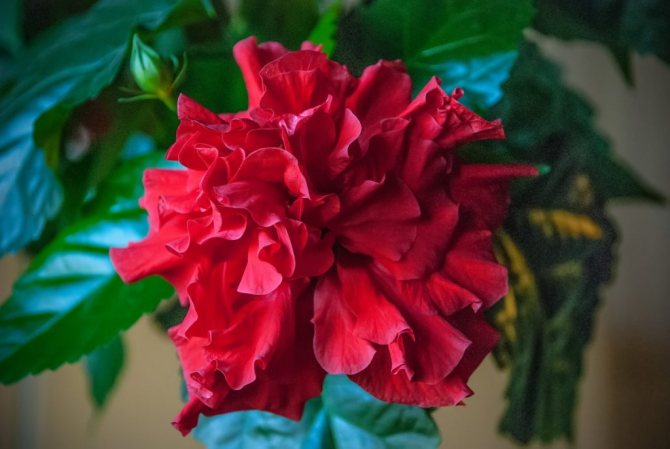

Hibiscus
Growing from seeds can be carried out in the garden, at home, in the greenhouse. Looks spectacular against the background of a hedge with curly varieties of flowers.
back to menu ↑
See also: Perennial flowers (33 main species): garden catalog for a summer residence with photos and names | Video + Reviews
Climbing roses
Many gardeners for landscape decoration plant climbing varieties of roses on the site. They are used to decorate fences, arches, decorative supports, building facades. A blooming oasis always becomes an object of admiration, a highlight of the landscape. There are a huge number of varieties of climbing roses.
Therefore, there should be no problems with the choice, everyone chooses the one that he liked the most: from 3 meters in length of shoots to 3, undersized or giants, 15 m high, too branched or half-lined.
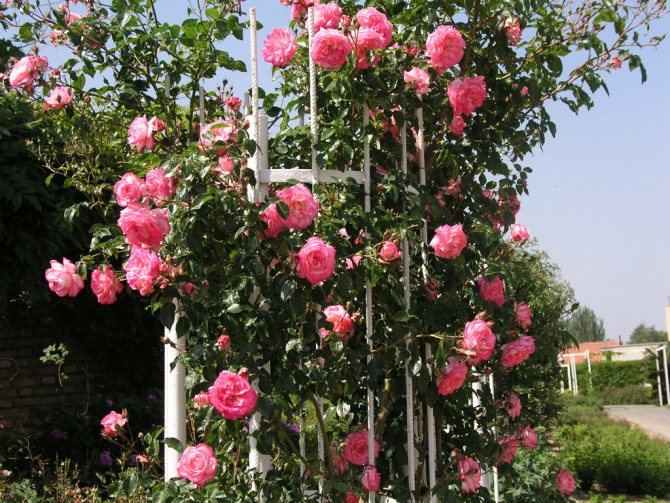

Harlequin Climbing
They reproduce mainly by cuttings, but the seed method of growing is acceptable to them. Here you just have to work a little, put a lot of effort, gaining patience and endurance. But then you can admire the fruits of your labors for a long period of time, to the envy of your neighbors.
After the first shoots are born, you need to organize a full daylight hours for them at 10 o'clock. If natural lighting is not enough, you need to artificially illuminate the plants. Reduce watering during this period, avoid direct sunlight.
It will be necessary to transplant into open ground conditions when the air temperature stabilizes, frosts pass, and warm weather sets in. It is imperative to loosen the soil periodically. Care, further watering, feeding should be done in the same way as with adult plants.
back to menu ↑
See also: Princess Nasturtium: a familiar stranger. Description, types, growing from seeds, care (50 Photos & Videos) + Reviews
What is the difference from other types ↑
This species is very often confused with miniature, patio and even floribunda. Although some varieties are so close to them that sometimes even a specialist finds it difficult to answer this question.
However, polyanthus differs from floribunda in smaller stature, much more branches, smaller flowers, and there are usually many more roses on one branch.
With miniature, the main difference is in the shape of the bush and the shape of the bud. The bushes of miniature roses, although of the same size, are more compact, often the flowers are single, and even if several are collected in one inflorescence, there are not so many. The shape of the roses is more like a floribunda.
Advantages (pros) Polyantha-Rose
- the habit (appearance) is rather compact,
- these are low deciduous shrubs;
- leaves are glossy;
- predominantly double flowers of pink and red color are collected in racemose inflorescences; they are not large, but there are many of them;
- with appropriate care (regular watering, top dressing), the flowering is luxurious, long-lasting: the first flowers bloom at the beginning of the summer season, and the last ones - at the end of autumn (the southern coast of Crimea and the Black Sea coast of the Krasnodar Territory);
- they winter well, but after planting for the first 1-3 years, you need to insure yourself and cover them with spruce branches or build an air-dry shelter on arcs;
- They are not afraid of traditional pink diseases, the causative agents of which are Sphaerotheca pannosa Lev. var. rosae Voron and Marssonina rosae (Lib.), but when it is cool and damp in summer, they cannot resist mushrooms;
- they are practically not cut off, especially if they are used as ground cover shrubs; slightly trimmed on the sides in the borders; shorten the shoots knocking out of the desired contour with a standard culture. Plus sanitary pruning, which is mandatory for roses;
- perfectly cut with green (June-July) and lignified (autumn) cuttings (own-rooted);
- used in various elements of the design of the suburban area;
- stand in cut for a long time (within 2 weeks) without losing color.
Landing features
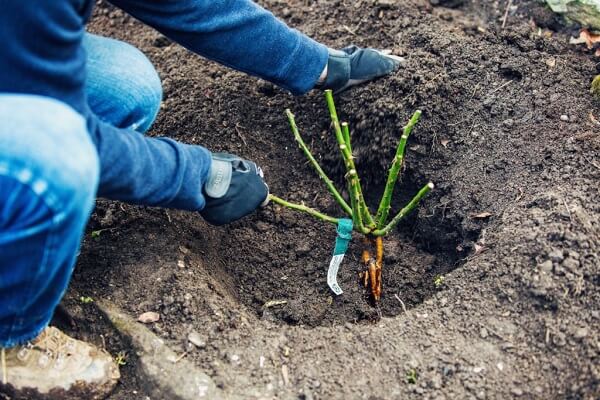

We will learn how to root a polyanthus rose correctly.
Pit preparation
To understand how large the hole is needed, estimate the volume of the seedling's roots. Keep in mind that the roots of the plant should be loose in the groove. The following components are introduced into the pit:
- wood ash - 200 gr;
- humus;
- complex minerals;
- with dense soil - river sand.
All components are mixed with the raised sod land dug from the pit before application.
Landing procedure
- A rose seedling is placed in the prepared and filled with substrate by a third.
- The roots of the plant spread freely along the bottom of the pit.
- The rest of the land is laid out. Along the way, the soil needs to be compacted.
- The seedling is watered, if necessary, mulched.
Attention: when planting, pay attention that the underground part of the plant is equal to the aboveground part.
Care advice
The main list of measures for the care of rose bushes of this type must necessarily include:
- carrying out mulching of the soil around the bushes, which allows the decorative culture to provide an optimal level of moisture;
- work in the direction of growth and fixation of shoots;
- pruning to obtain the most lush crown and in order to stimulate the shoot-forming ability;
- irrigation activities, the frequency of which depends on the characteristics of climatic and weather conditions;
- systematic shallow loosening of the soil;
- timely removal of all faded flowers;
- application of mineral complex and organic fertilizers;
- preventive measures aimed at protecting rose bushes from diseases and plant parasites.
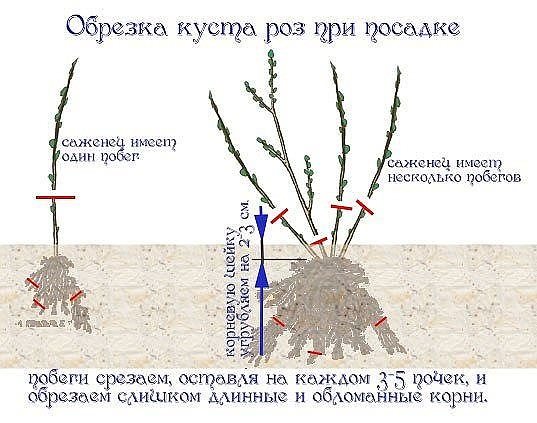

Compliance with simple care recommendations allows you to get a durable and abundantly blooming decorative culture.
Wintering
Although polyanthus roses are hardy, you also need to prepare them for wintering. This is especially important in central Russia.
From the second half of August, you need to stop watering, loosen and cut. In September, feed with potash fertilizers (ash). In October, cut off, remove the remnants of vegetation, huddle high.
When the frost is at -7 ° C, cover with spruce or pine spruce branches. If your winters are harsh, build a wooden frame over the roses and cover it with lutrasil.
Characteristics and features
Hybrid-polyanthus roses were bred at the end of the 19th century by the famous breeder Jean-Baptiste Guillot and were the result of crossing Rosa chinensis and Rosa multiflora. The resulting varieties were characterized by abundant and long flowering. Their description suggested the formation of numerous inflorescences, represented by semi-double flowers. Also varietal advantages could be attributed to enviable resistance to fungal infection and excellent winter hardiness.
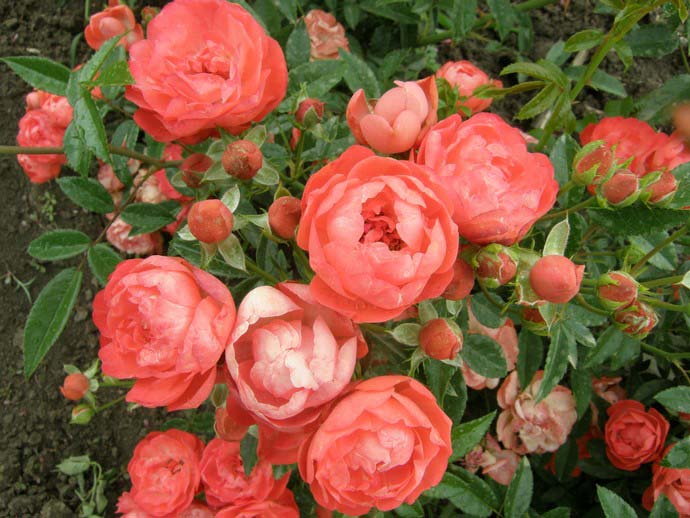

Polyanthus rose reaches a height of no more than 30–40 cm, and the characteristic common for all varieties of this type of ornamental culture involves the formation of highly branched bushes with sufficient foliage. The somewhat limited color palette of flowers is easily compensated for by the high decorative level of foliage. Further work on hybridization of the species allowed breeders to breed orange polyanthus roses, but this decorative species with a yellow tint of flowers is still missing.
The angelic polyanthus rose, which grows to a height of no more than 25-30 cm, is widespread and stands out with semi-double fragrant flowers 2-4 cm in diameter, lilac, pink or white. Most of the popular varieties of polyanthus rose are native to England. Constantly blooming polyanthus roses are great for decorating garden paths and are widely in demand when decorating flower beds with various perennial ornamental crops.
The nuances of growing a rose from a seed
Units of rose bushes are capable of hatching from seeds.Usually these are non-hybrid varieties in which full-fledged developed seeds ripen. In addition to the polyanthus, this breeding method is relevant for canina, needlepoint and miniature roses.
Summer residents distinguish the following features of seed growing of roses:
- The method is the simplest and most economical. The seeds can be bought at the store or taken from the mother bush yourself.
- The rose bush obtained from the seed retains all the characteristics of the mother plant.
- It is relevant in cases where the mother plant has full-fledged healthy seeds.
- It is used to breed new unusual varieties.
Important! It is not recommended to propagate polyanthus hybrids by seeds. Flowers on such a bush will differ from the source. They will grow similar to the wild crop that was the progenitor of the hybrid.
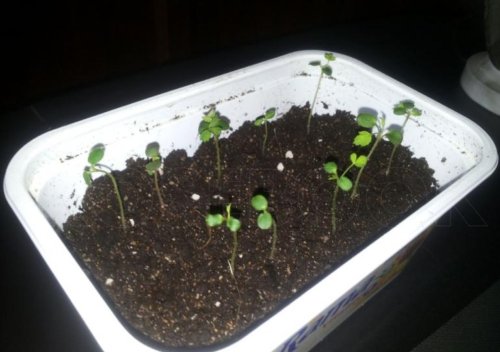

Hatching rose seeds a few days after planting
Reproduction
Polyanthus roses reproduce very easily. Cuttings of these flowers take root easily; with good care, there is practically no lunge. In addition to cuttings, seedlings of polyanthus roses can be obtained from seeds.
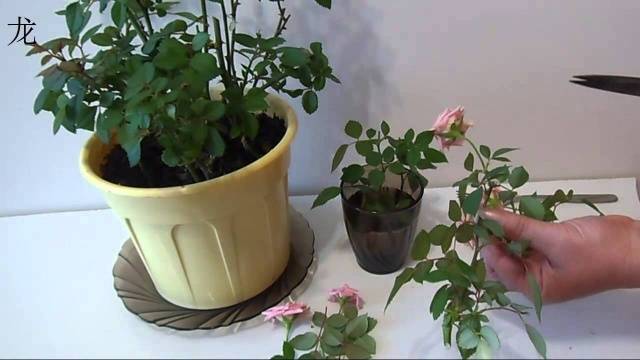

Cuttings
For cuttings, healthy green shoots are chosen for flowers, up to 15 cm in size. They are cut with a very sharp knife so that the cut is even, without protruding fibers. Before planting, rose cuttings can be soaked in a stimulant solution according to the instructions.
Cuttings are placed in a container with a damp, clean substrate to reduce evaporation of water, covered with a lid or plastic bag. The following substrates can be used to germinate flower cuttings:
Peat absorbs water well, but dries out very quickly, it is necessary to constantly monitor the moisture content of the soil. Cuttings can die even after a short drying of the substrate. May contain fungal spores and microorganisms harmful to cuttings.
Coconut fibers work well for growing a rose from cuttings. Cuttings growing in peat are rarely affected by mold or rot.
Perlite absorbs well and releases water when cuttings need it. With its help, it is easy to provide cuttings of polyanthus roses with the necessary moisture. Free from harmful microorganisms.
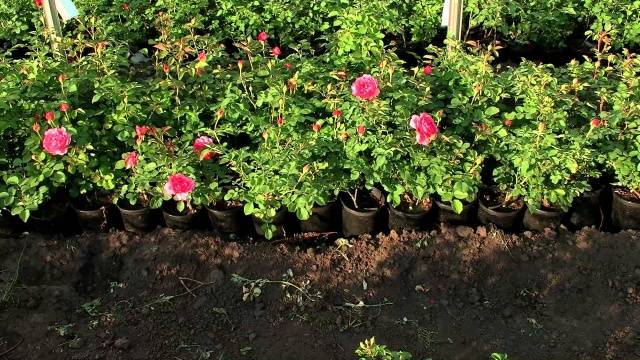

Wet sawdust can only be used to germinate flower cuttings with treated fungicides. They can contain microflora harmful to flowers in large quantities. It is required to carefully monitor the uniform moisture.
Sand is the least suitable for growing cuttings. It is easily compressed, it is easy to overmoisten. The resulting root system of flowers will experience oxygen starvation. It is advisable to heat the sand to get rid of pathogenic microorganisms.
When the first roots appear, the flower seedlings are transplanted. For further cultivation, roses will need bright sunlight, a lot of nutrients.
You can plant flowers in a temporary bed, the so-called school, or grow flowers before planting in a permanent place in containers. The basic rule is that young roses can be harmed by direct sunlight and overdrying.
In hot weather, the temperature under the plastic wrap can be too high, so agrofibre is the best choice. Seedlings of these flowers are planted in a permanent place the next year.
Growing from seeds
When growing a rose from seeds, it must be borne in mind that not all seedlings inherit maternal characteristics. Some flowers will not look at all like the rose from which the seeds were taken.
The seeds of most varieties of polyanthus roses require mandatory stratification, except for the Chinese rose "Angel Wings", another name is the angelic rose. Its seeds germinate well and quickly, the seedlings begin to bloom a few months after sowing the seeds.
The seeds of polyanthus roses are treated with disinfectants, dried, then soaked in a stimulant solution.They are planted in clean soil, wrapped in a plastic bag and placed in a cold place for 2 - 3 months. The seeds of these flowers need freezing temperatures to activate growth, so they can be dug in the garden along with the container. If seed roses are grown at home, you can place the container in the freezer.
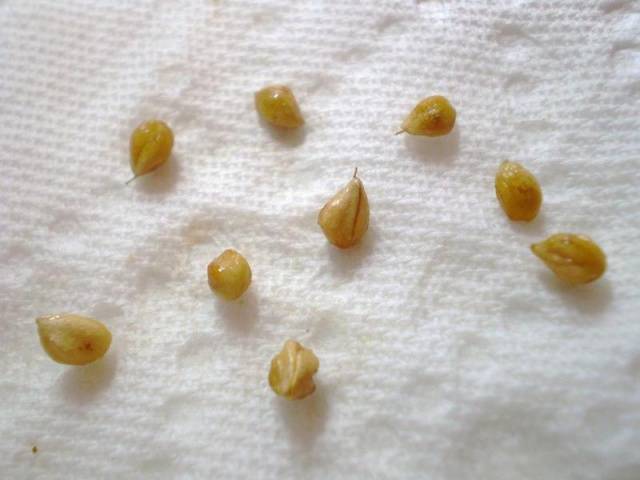

In the spring, the container is taken out, transferred to a warm, bright place. After 2 - 3 weeks, the first shoots of flowers appear. After their appearance, the plastic film is removed, the first 3 days it is necessary to spray the flower seedlings 2 - 3 times a day.
Flower seedlings are planted in a permanent place when the threat of frost has passed.
Photo
Introduction
The seed propagation method is often used when you need to get a lot of seedlings at once and when the grower, having one or more varieties that he likes, wants to increase their number. All the characteristics and traits of the mother plant are embedded in the grain and retained for a long time.
They also use this technique when mother plants need to be replaced by young animals due to old age, freezing or illness. This technique is not only convenient, but also economical in terms of money costs. In addition, no one knows what quality the purchased seed will have. The samples that are presented in the description of online stores do not always correspond to the actual ones.
When growing or renewing a rose garden by seed, you need to be prepared for the fact that the first shoots may be wild. They need to be pruned without regret, otherwise a plant called a rose will turn into a plant called a wild rose. Cut off wild shoots right at the root system. A simple shortening of the situation cannot be remedied.
Not every variety of roses can be propagated by seed. You cannot grow a hybrid rose in this way. The seeds of these plants do not contain the maternal gene.
This method is suitable for the following cultivars:
- Chinese rose
- miniature varieties
- cinnamon
- polyanthus
- spiny
- angel wings
- hellebore
- stockrose (mallow)
- stone (young)
- lavender
CARE
Caring for bushes of polyanthus roses is not difficult, often for the full development of roses, timely watering and pruning is enough. In some cases, the bushes of these flowers may need treatment for insects and fungal infections. How to use insecticides and fungicides correctly is indicated in the instructions.
Bushes of polyanthus roses easily tolerate even prolonged waterlogging of the soil, but this can affect flowering. Therefore, watering the bushes is carried out only when the soil is well dried. Usually, watering once a week is enough for rose bushes.
It is advisable to prune bushes several times, the first time it is carried out in early spring, when the first leaves begin to appear on the flowers.
In spring, branches damaged by frost and remnants of old leaves should be removed from the bushes. No more than three trunks are left on the bush, they must be shortened by a third. Branches growing inside the bush are also removed.


During the growing season, you can form a bush to get a more decorative flower. If the tip is removed from the green branch, it will begin to release new branches. A flowering brush will appear at the end of each of these processes by mid-summer.
Bushes of polyanthus roses very rarely get sick, but in cool rainy weather spores of pathogenic fungi begin to actively multiply. If you have recently pruned the bushes, fungi can get into the flower through a fresh cut. To avoid infection, pruning of bushes should be done only in dry weather.
Pest insects rarely cause serious damage to polyanthus rose bushes. Since the flowers of this rose have no scent, most flying insects do not notice it. Of the sucking insects, most often the bushes are annoyed by aphids. Aphid treatment is carried out in dry, calm weather. A solution of the aphid drug is prepared following the instructions. Usually 2 - 3 color treatments are required per season.
Problems that growers may face
It is clear from all of the above that growing roses from seed is an easy process, but long, labor-intensive. Except those that do not require stratification. Here you need to make a certain amount of effort, stock up on endurance and patience before the first sprouts and flowers appear. But these are far from the greatest difficulties in growing and caring for roses.
Much more frustration and trouble can be brought by weeds that got into the bag when packing the seed. Especially if the seed is purchased and money has been paid for it. This is not uncommon when selling planting material on inexpensive trading platforms.. There, they practically do not sort the seed before selling it. Therefore, a lot of grass and other weeds are often included in a bag with supposedly roses.
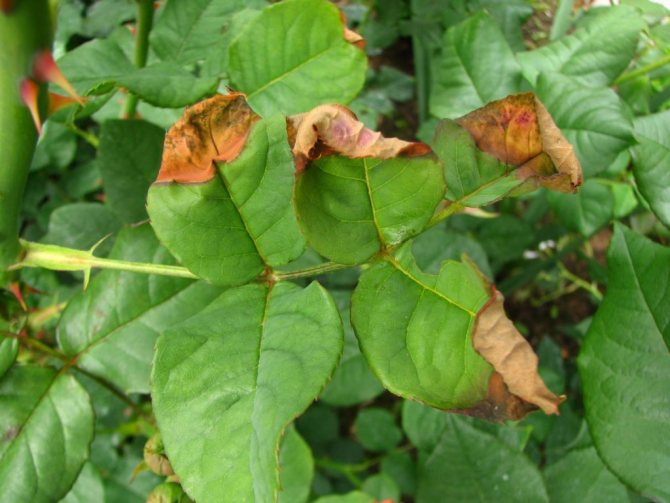

Plant leaf disease
They can also get into the seed of a rose during private collection, so you need to monitor this and remove them in a timely manner. What happens if they are not removed? During germination, they negatively affect their contributing "cultured" brethren. Simply put, they will in every possible way hinder their healthy growth and development.
It is important to understand that some roses are intended to be grown in certain climatic conditions, if they do not match, then the result may be zero. The florist will have to try pretty hard to create the most suitable habitat for them.
When choosing varieties in China, many, before buying, looking for detailed information, find out the fact of the presence of GMOs in the seed. Genetically modified products are not considered to be of high quality, but roses are not eaten, therefore this fact cannot be considered a significant drawback. The main thing is to succeed in growing the beauty of the garden.
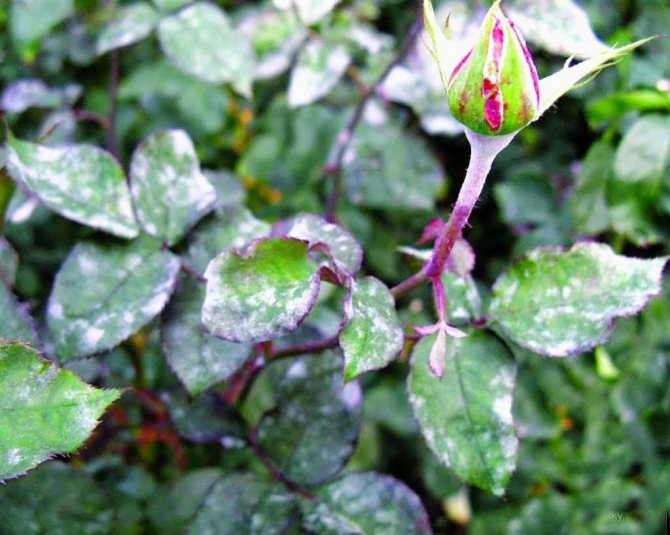

Powdery mildew
Compliance with all the rules is a guarantee that after a short time (next season) they will bloom regularly and profusely. Some varieties will delight in abundant color all summer and a little autumn. A self-grown rose is the best, brightest and most beloved plant - a highlight in decorating a garden or apartment.
See also: Sea buckthorn: a description of the 20 best varieties. Large-fruited, without thorns and frost-resistant + Reviews
Features of seed growing
This method of growing a plant has its own nuances that you need to know before you start directly cultivating flowers.
The method is most often used in cases where an adult plant is capable of producing full-fledged seeds suitable for further cultivation. Not all varieties are capable of this. In addition, the seed method is indispensable for breeding and breeding new varieties.
Hybrid varieties of the polyanthus rose are not capable of propagating by seeds. This rule, by the way, applies to all cultivated plants, not just the rose. Rather, the plant itself will grow, however, the flowers will have a color and bud shape that is different from the mother, close to the "wild" original varieties.
In fact, only the following types of roses are suitable for seed propagation:
- miniature polyanthus;
- brown, belonging to the genus of rose hips;
- spiny;
- canina and a few other species.
Seed preparation
Before planting in the ground, the seeds of a polyanthus rose require compulsory simple preparation. The seeds that were collected from slightly unripe bolls germinate in the best way, so experienced gardeners collect material at the end of summer.
The seeds are removed from the bolls as follows: the boll is cut, the pulp is separated, and the seed material is gently pulled out. Keep in mind that seeds, even in the same box, can be of different shapes and sizes. This is not considered a defect, as long as they are outwardly without damage.
Check the seed for dry and rotten specimens. If you find defective seeds, discard them immediately.
When preparing seeds for sowing, they should not be dried, but only need to be rinsed in hydrogen peroxide. The procedure is carried out in a sieve, and is aimed at destroying pests and microbes. In addition, washing also prevents the appearance of mold and rot on adult plants. It will also be interesting to know how the stem rose from seeds is grown at home.
Stratification
After the seeds are ready for planting, it is necessary to start their initial germination. Stratification is quite an important condition for the normal development, successful growth and flowering of the polyanthus rose. The term means in translation "interlayering". This means that before germination, the seeds must lie under a moist, cold layer of earth or snow. The procedure allows you to harden the seeds and provide them with optimal moisture.
The seeds of a polyanthus rose are not sown directly into the ground, but they do it on a special substrate made of thin paper (you can use toilet paper or napkins), fabric. It is important that the substrate can provide the seed with an adequate level of moisture while retaining moisture. The substrate must be moistened with peroxide, and then sprinkled with seeds and covered with the same material. But how the stratification of Lavender seeds in the refrigerator occurs, and how to do it correctly, is described in this article.
On video stratification of a rose:
The material with the seeds must be removed in a plastic container and placed in the refrigerator away from the freezer. The seeds will stay in this cool place for a couple of months. Check periodically to see if the backing is dry: if you find a problem, moisten the material.
Within two months, the seeds first stratify and then germinate. After the sprouts have hatched, they must immediately be transplanted into a peat substrate in a pot. If a seed is found that has hatched ahead of time, it should be sown immediately, otherwise the sprout will die in the cold. First, miniature pots should be prepared for seeds. In the future, after germination of the seeds, the containers can be changed to more voluminous ones.
How the planting and leaving of the Iberis umbrella occurs, and how good such flowers look, you can see and find out in this article.
But how the perennial Coreopsis is planted, and in which part of the garden it is worth planting this plant, is described in this article.
maybe
Main characteristics
Blossoming of polyanthus roses occurs on all young shoots, it begins in mid-June and lasts until late autumn.


This type of plant tolerates winter cold very well with proper shelter. Even if some shoots freeze, the shrub quickly recovers and sprouts new branches from the root.
Another advantage of this subspecies is the presence of immunity to fungal diseases and the ability to grow in humid climates. Such shrubs take root very quickly.
Growing a polyanthus rose from seeds at home
This is the only type of rose that can be grown from seed. Seed material is harvested from adult plants over 3 years old. It is they who can give high-quality seeds from which a full-fledged decorative flowering culture will grow.
Seed collection
The seed is harvested in the middle or late summer, after the flowers have wither. Seed boxes should be slightly unripe, not overdried. The box is cut or husked by hand, the pulp is separated and the seeds are pounded.
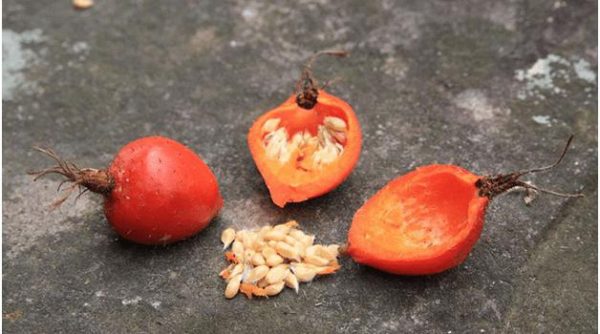

Damaged or rotten seeds are removed. Then clean, strong seeds are washed in a weak, cold solution of manganese. Hollow seeds floating on the surface of the liquid are thrown away. Then they are mixed with sand, wrapped in gauze soaked in hydrogen peroxide (3%).
Stratification
In order for the reproduction of a polyanthus rose by seeds to be successful, they must be stratified (soften the hard shell) before planting. For this, the seeds are spread in a thin layer on the surface of a cloth dipped in water, and covered with the same moistened material on top. The fabric can be rolled, wrapped in plastic, or sent to a plastic container. Then the seeds of the polyanthus rose are placed in the refrigerator on the lower shelf for 1.5-2 months. A periodically drying cloth is moistened.
Germination and planting
As soon as the hard shell on the seeds of polyanthus roses begins to disperse, they can be sown in separate pots. The soil for planting is chosen fertile, light and loose; you need to mix it with a small amount of sand. Before planting, the soil must be sterilized. To do this, it is heated in the oven, or poured with boiling water, having previously diluted manganese in it. Peat can be used instead of soil.
Planting containers are filled with earth, make small depressions, and plant seeds in them.
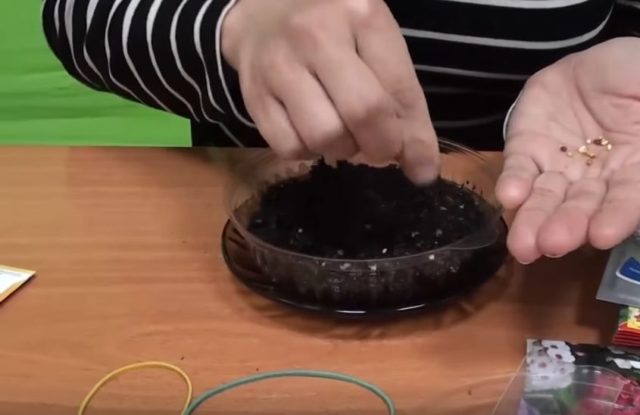

Sprinkle on top with a thin layer of fluffed earth, watered. The pots are placed in a well-lit place. Daylight hours for seedlings should be at least 10 hours. The air temperature should not fall below + 18 ᵒС. Before the first shoots appear, the seedlings are watered as the soil dries. Every day for half an hour, the windows are opened, airing is done - growing seedlings need access to fresh air. The video shows how polyanthus roses are grown from seeds:
After about 2 weeks, the first shoots will appear. As soon as they stretch out a little, you can add fertilizing with nitrogen, potassium or phosphorus. Fertilizing will help the plant grow stronger.
In the spring, before planting, the seedlings of the polyanthus rose are hardened: they are taken out into the street at freezing temperatures for several minutes. The air bath time is increased daily. 2 weeks before planting, rose seedlings are mulched with perlite. This will prevent the development of fungal diseases.
Landing in open ground
Polyanthus roses of the first year are not recommended to be planted in open ground, they may not take root. In the second year, mature plants are rooted in the garden or in the garden, as soon as the probability of night frosts approaches zero. This is the period from mid-May to early June. At this time, the first buds may already appear on the grown rose bushes.
The planting hole is dug 2 times wider and deeper than the rhizome of the plant, it should fit freely there. Bushes of polyanthus roses are planted according to the scheme 40X60 cm. A small layer of fertile soil is placed on the bottom of the pit, mixed with 1 tbsp. l. complex mineral fertilizer.
The seedling is placed in the center of the hole, sprinkled with fluffy soil mixed with a small amount of sand, watered and mulched. After a few days, the soil around the bush is loosened.
